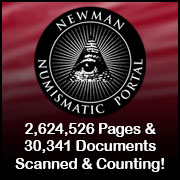
About UsThe Numismatic Bibliomania Society is a non-profit association devoted to the study and enjoyment of numismatic literature. For more information please see our web site at coinbooks.org SubscriptionsThose wishing to become new E-Sylum subscribers (or wishing to Unsubscribe) can go to the following web page link MembershipThere is a membership application available on the web site Membership Application To join, print the application and return it with your check to the address printed on the application. Print/Digital membership is $40 to addresses in the U.S., and $60 elsewhere. A digital-only membership is available for $25. For those without web access, write to: Charles Heck, Treasurer
AsylumFor Asylum mailing address changes and other membership questions, contact Chuck at this email address: treasurer@coinbooks.org SubmissionsTo submit items for publication in The E-Sylum, write to the Editor at this address: whomren@gmail.com BUY THE BOOK BEFORE THE COIN |
- WAYNE'S WORDS: THE E-SYLUM AUGUST 14, 2019
- NBS EVENTS AT 2019 ANA WORLD'S FAIR OF MONEY
- 2019 NBS BENEFIT AUCTION SALE
- KOLBE & FANNING AT THE 2019 ANA
- CHARLES DAVIS OFFERING LITERATURE AT THE 2019 ANA
- KARL MOULTON OFFERING LITERATURE AT 2019 ANA
- NEW BOOK: THALERS AND PENCE
- NEW BOOK: NEW MEXICO TRADE TOKENS III
- NEW BOOK: THE NABLUS 1968 HOARD
- NEW BOOK: CONNECTIONS, COMMUNITIES, AND COINAGE
- NEW BOOK: THE EARLY ANTIGONIDS
- NEW BOOK: THE CRYPTONOTE BOOK
- NEW BOOK: A LINKED OPEN WORLD
- REMEMBERING SIMON BENDALL
- HERITAGE BULLET SALES ON NEWMAN PORTAL
- VIDEO: 2019 SUMMER FUN: TREASURE TRIVIA
- ARTICLE EXAMINES SS CENTRAL AMERICA COIN RUST
- MORE ON RESEARCHER "NIEL" NIELSEN
- NOTES FROM E-SYLUM READERS: AUGUST 11, 2019
- FACT-CHECKING THE INVENTION OF MONEY
- RICHARD STOCKLEY BOOKS AT 2019 RCNA SHOW
- VOCABULARY TERM: REDUCTION PUNCH
- MAX HEILBRONNER (1848-1906)
- HARVEY STACK'S NUMISMATIC FAMILY, PART 50
- ANA AWARDS HALLENBECK, HUNTOON, AND SAMMUT
- ANA AWARDS BEST, DE LEóN TALLAVAS, FITTS
- COUNTERFEIT COIN MAKERS IN INDIA
- POLISH 17TH CENTURY SILVER COIN HOARD FOUND
- ROYAL MINT REDUCES COIN PRODUCTION
- THE BOWERS COLLECTION OF ENCASED POSTAGE STAMPS
- STEPPING THE MAST WITH PENGUINS
- MEXICO MINT GOLD COIN ROBBERY
- LIFE AND DEATH OF THE BIN LADEN
- TOM BADLEY'S PORTFOLIO OF MONEY
Click here to access the complete archive
To comment or submit articles, reply to whomren@gmail.com
Content presented in The E-Sylum is not necessarily researched or independently fact-checked, and views expressed do not necessarily represent those of the Numismatic Bibliomania Society.
WAYNE'S WORDS: THE E-SYLUM AUGUST 14, 2019
 This week we open with
several items on the upcoming ANA World's Fair of Money, SEVEN new books, remembrances of numismatic scholar Simon Bendall, and updates from the Newman
Numismatic Portal.
This week we open with
several items on the upcoming ANA World's Fair of Money, SEVEN new books, remembrances of numismatic scholar Simon Bendall, and updates from the Newman
Numismatic Portal.
Other topics this week include Dick Johnson, rust on the SS Central America gold coins, a numismatic literature dealer's boffo debut, dealer Max Heilbronner, ANA Awards, counterfeit coin makers in India, Royal Mint coin production, the Mexico Mint gold robbery suspects, and banknote designer Tom Badley.
To learn more about foreign coins circulating in the English colonies, physical cryptocurrency, numismatics and the semantic web, Heritage Bullet Auctions, safe deposit box safety, reduction punches, U.S. encased postage stamps, the Trump note and vigilante numismatics, read on. Have a great week, everyone!
Wayne Homren
Editor, The E-Sylum
NBS EVENTS AT 2019 ANA WORLD'S FAIR OF MONEY
It's the most wonderful time of the year (for NBS members and bibliophiles, anyway)! Here's your final reminder from President Tom Harrison of NBS events at next week's American Numismatic Association World's Fair of Money. I hope to see many of you there! -Editor
 As the Numismatic
Bibliomania Society celebrates its 40th anniversary, I would like to remind everyone of the upcoming NBS events at the ANA Convention in Rosemont. Highlights
of the week will feature the NBS club table located near literature dealers Charles Davis and Kolbe & Fanning. We will be displaying special items from
Friday's benefit auction. In addition, for a $25 donation, you will receive a NBS 40th anniversary commemorative coffee mug. Please stop by and share your
enthusiasm and ideas for the betterment of NBS.
As the Numismatic
Bibliomania Society celebrates its 40th anniversary, I would like to remind everyone of the upcoming NBS events at the ANA Convention in Rosemont. Highlights
of the week will feature the NBS club table located near literature dealers Charles Davis and Kolbe & Fanning. We will be displaying special items from
Friday's benefit auction. In addition, for a $25 donation, you will receive a NBS 40th anniversary commemorative coffee mug. Please stop by and share your
enthusiasm and ideas for the betterment of NBS.
Our Symposium is scheduled for Thursday the 15th at 1:00 in room 23. We are delighted to welcome American Numismatic Society Deputy Director, Dr. Gilles Bransbourg, sharing news from the ANS. Also, we are looking forward to NBS Vice President, Len Augsburger's, presentation about the legendary first six volumes of The Numismatist.
On Friday in room 44 at 11:30 our General Meeting will include the announcement of The Asylum author award winners. As well, we are looking forward to Newman Numismatic Portal Coordinator, Len Augsburger, and The E-Sylum Editor, Wayne Homren, reporting on the Newman Numismatic Portal and The E-Sylum respectively. The meeting will also feature our one major annual fundraiser, the all important benefit auction.
We hope you will be able to join us to connect with friends, old and new, as we support the mission of the NBS. Finally, I would like to share a sincere word of gratitude to the many staunch supporters of the NBS whose combined efforts will ensure another successful week of biblio fun and fellowship!
2019 NBS BENEFIT AUCTION SALE
NBS Vice President Len Augsburger sends this reminder of the upcoming NBS Benefit Auction. Come ready to bid! -Editor
NBS To Hold Benefit Auction Sale at ANA Convention

As is customary, the NBS will conduct a benefit auction sale during its annual meeting at the ANA Convention in Chicago. This year’s event will be on Friday, August 16, at 11:30am in room 44. Hijinx and hilarity are no strangers to these events, and even non-bidders in the audience will be highly entertained. David Fanning has expertly cataloged 50 donated lots, and hardcopies of the auction sale catalog will be available at the event. A few highlights:
Lot 18: Complete set of Empire Topics & Review (donated by David Gladfelter). This lot includes all 19 issues of the Q. David Bowers house publications prior to Rare Coin Review, covering the period 1958-1964.
Lot 30: An original set of Loubat’s magnum opus on American medals, The Medallic History of the United States, treating the period 1776-1876 (donated by Tony Lopez). Loubat spared no expense in the research and production of this two-volume set, and, if the content itself isn’t compelling enough, the physical presentation ought to do the trick.
Lot 39: Hardbound copy of Pine Tree’s GENA ’74 auction sale catalog. Rare in this format. The sale includes the Morris Judd-1 silver center cent, as catalogued by Walter Breen, a coin which has captured considerable attention as of late. Donated by Dan Hamelberg.
Lot 47: The first 16 auction sale catalogs of Charles Steigerwalt, nine of which are hand-priced, bound in one volume. Donated by Len Augsburger.
There's something for everyone in this short sale, including the first plated U.S. numismatic auction sale catalog, Kraay & Hirmer's Greek Coins, hardbound and Deluxe Leatherbound auction catalogs, and works on U.S. colonial coinage and paper money. -Editor
KOLBE & FANNING AT THE 2019 ANA
George Kolbe and David Fanning of Kolbe & Fanning Numismatic Booksellers will be set up at the 2019 ANA convention. Be sure to stop by. -Editor


Drop by Booth 931 to browse numismatic titles and visit with David and George at the American Numismatic Association's World's Fair of Money from Tuesday, August 13–17 at the Donald E. Stephens Convention Center in Rosemont, Illinois.
We will be located with the Numismatic Bibliomania Society and Charles Davis Numismatic Literature booths.
To visit the Kolbe & Fanning web site, see:
David Fanning https://www.numislit.com/
CHARLES DAVIS OFFERING LITERATURE AT THE 2019 ANA
Numismatic literature dealer Charlie Davis writes:
I will be table 925-927 with a selection of literature from the estates of Rick Bagg & Jim King (American works) and James Robertson and Dave MacDonald (British). All four loved their books and are sorely missed.
Charlie will be right alongside the Numismatic Bibliomania Society table, so stop on by at the show. -Editor
To visit Charlie's web site, see:
https://www.numisbook.com/

KARL MOULTON OFFERING LITERATURE AT 2019 ANA
Karl Moulton writes:"I will be sharing a table (#1656) with fellow author, Steve Tompkins; and I will have two cases of literature from my reference library available for sale. The selection offers some rare 19th century items, along with some desirable 20th century sales. Check out the list below, and be sure to stop by to see the eclectic selection of merchandise we will have on hand".
There are some great works here - be sure to stop and see Karl if you're at the show. -Editor
- 1846 - Pledges of History, original hardbound, W.E. DuBois
- 1849 – “Mint Manual”, hardbound, w/gold samples, Eckfeldt & DuBois
- 1858 – Historical Account, hardbound, near mint, Hickox
- 1858 – Philadelphia Historical Society, hardbound, wampum foldout
- 1861 – Washington Medals, Deluxe Edition, hardbound, Snowden
- 1865-6 – Continental Paper Currency, 2 Vols., Hardbound, Phillips
- 1866 - New York Bills of Credit, Large Paper, hardbound, Hickox
- 1869 – Bibliotheca Americana, W.E. Woodward library, Woodward
- 1875 – Coin Book, History of Coinage, hardbound, Homans
- 1878 – Medallic History of United States, 2 Vols., original covers, Loubat
- 1880 – Current Gold & Silver Coins of all Nations, hardbound, Michels
- 1883 – U.S. Copper Cents 1816-1857, original hardbound, Andrews
- 1883 – U.S. Half Dimes, 2nd edition, original hardbound, Valentine
- 1890 – Thomas Cleneay catalogue, Plated, hardbound, Chapman Bros.
- 1908 – James Wilson catalogue, Plated, original covers, Elder
- 1945 – World’s Greatest Collection, Deluxe, hardbound, Kosoff
- 1981 – Private Gold Coins & Patterns of U.S., Deluxe, hardbound, Kagin
- 1997 – John J. Pittman sales, 3 Vols., Hardbound, matched set, Akers
NEW BOOK: THALERS AND PENCE
Well, this one was published in 2015, but it's new to me and probably a lot of readers. Ray Williams asks, "Has anyone read this book? I'm just looking for an opinion about its worth. I never heard of this author." Here's the Amazon description. Can anyone comment? -Editor
 Thalers and
Pence
Thalers and
Pence
by Kenneth H Gossard (Author)
Engaging history of foreign coins circulating in the English colonies and the young nation of the United States. Useful for both collectors and historians.
Paperback: 146 pages
Publisher: Blurb (December 14, 2015)
Language: English
ISBN-10: 1364666227
ISBN-13: 978-1364666224
Product Dimensions: 8 x 0.4 x 10 inches
For more information, or to order, see:
Thalers and Pence
(https://www.amazon.com/Thalers-Pence-Kenneth-H-Gossard/dp/1364666227)
NEW BOOK: NEW MEXICO TRADE TOKENS III
Author Billy Kiser forwarded this information about the latest edition of his book on the trade tokens of New Mexico. Thanks! -Editor
New Mexico Trade Tokens III
by Billy Kiser
 This completely updated and revised third edition of the New Mexico trade tokens reference catalog features
over 2,500 token listings (including more than 300 new listings since the previous edition was published in 2009). It also includes more than 3,000
photographs, with obverse and reverse images of all tokens. Previous editions of this book had only obverse images. All of the token photos have been redone
using a high resolution scanner to improve consistency and clarity. Every token listing includes a rarity designation and a price, in addition to historical
information gleaned from extensive research in business directories, newspapers, photographs, Ancestry.com, and other sources. An alphabetical maverick index
helps to identify tokens that do not have the town name on them. Finally, the book includes detailed information on fake and fantasy tokens to help identify
these items and hopefully prevent their circulation in the token collecting community.
This completely updated and revised third edition of the New Mexico trade tokens reference catalog features
over 2,500 token listings (including more than 300 new listings since the previous edition was published in 2009). It also includes more than 3,000
photographs, with obverse and reverse images of all tokens. Previous editions of this book had only obverse images. All of the token photos have been redone
using a high resolution scanner to improve consistency and clarity. Every token listing includes a rarity designation and a price, in addition to historical
information gleaned from extensive research in business directories, newspapers, photographs, Ancestry.com, and other sources. An alphabetical maverick index
helps to identify tokens that do not have the town name on them. Finally, the book includes detailed information on fake and fantasy tokens to help identify
these items and hopefully prevent their circulation in the token collecting community.
Book Specifications: 8.5” x 11” spiral bound, 60-weight paper
Color Copy: $50 (shipping included)
B&W Copy: $30 (shipping included)
Please mail check or money order to:
Billy Kiser
10947 Redbush Park
San Antonio, TX 78249
Email: bkiser86@yahoo.com


To read the earlier E-Sylum article, see:
NEW BOOK: NEW MEXICO TRADE TOKENS II (https://www.coinbooks.org/esylum_v12n09a05.html)
NEW BOOK: THE NABLUS 1968 HOARD
The American Numismatic Society has announced three new books which will go to the printer in August and will ship to readers in October. All are available for preorder. The first is on the 1968 Nablus hoard. -Editor
 The Nablus 1968 Hoard
The Nablus 1968 Hoard
A Study of Monetary Circulation in the Late Fourth and Early Third Centuries BCE Southern Levant
(Numismatic Notes and Monographs 171)
by Haim Gitler and Oren Tal with contributions by Arnold Spaer, Sylvia Hurter, Dana Ashkenazi, and Adin Stern
List price: $75 plus shipping & handling
Member price: $52.50 plus shipping & handling ISSN 0078-2718
ISBN 978-0-89722-360-7 Hardcover, 256 pages, incl. 32 b/w figures and 42 b/w plates
The Nablus 1968 Hoard is the largest late Persian/early Hellenistic period coin and jewelry hoard recorded from the southern Levant and the largest known hoarded assemblage of Samarian coins. This study provides a detailed catalogue of all the coins and pieces of jewelry the authors managed to record. In addition, the authors discuss the hoard and its context, its burial date, a synopsis of the history and archaeology of the Persian period province of Samaria, a discussion on the hoard’s Phoenician, Samarian, Athenian-styled, Philistian, and Yehud coins, Athenian tetradrachms and the few overseas Greek and Cypriot issues belonging to the hoard. The commentary chapter is followed by detailed archaeometallurgical studies on selected Samarian and Athenian-style coins and selected pieces of jewelry. There are also appendixes There are also two appendixes, one presenting a method for determining dies links and the second offering a glossary of relevant terms. The hoard’s composition reflects the monetary circulation of the late fourth and early third centuries BCE southern Levant.
ABOUT THE AUTHORS
Haim Gitler, born in Mexico City in 1962, received his Ph.D. in numismatics from Nicolaus Copernicus University, Torun in 2011. He has worked in the Israel Museum (since 1987), where he is currently the Tamar and Teddy Kollek Chief Curator of Archaeology (since 2013), as well as Curator of Numismatics (since 1994). Gitler taught numismatics at the Hebrew University, Jerusalem (1996–1998) and Tel Aviv University (2010–2014). He is the President of the Israel Numismatic Society and founder of the journal Israel Numismatic Research in 2006. His research interests focus mainly on Palestinian issues and mints of the Persian, Hellenistic and Roman periods, as well as on their metal composition and quantification.
Oren Tal, born in Tel Aviv in 1968, received his Ph.D. in archaeology from Tel Aviv University in 2002. He has worked in Tel Aviv University (since 2007) where he is currently full professor (since 2013) researching and teaching classical and medieval Near Eastern archaeology in the Department of Archaeology and Ancient Near Eastern Cultures. Tal is the current Director of the Apollonia-Arsuf Excavation Project (since 2007) and co-director of the Tell I??abba (Scythopolis) Excavation Project (since 2019). His research interests concern the material culture of the classical- and medieval-period Near East and its social, political, and economic implications, from the mid-first millennium BCE to the early second millennium CE.
Order this title from our distributor, Casemate Academic/Oxbow Books. ANS Members, use your discount code at checkout. Forgot the code? Email Emma Pratte, or call 212.571.4470 x117.
For more information, or to order, see:
The Nablus 1968 Hoard (http://numismatics.org/store/nablus/)

NEW BOOK: CONNECTIONS, COMMUNITIES, AND COINAGE
This ANS title is on coin production in southern Asia Minor. -Editor
 Connections, Communities, and Coinage
Connections, Communities, and Coinage
The System of Coin Production in Southern Asia Minor, AD 218–276 (Numismatic Studies 39)
by George Watson
List price: $100 plus shipping & handling
Member price: $70 plus shipping & handling
ISSN 0517-404-x
ISBN 978-0-89722-358-4
Hardcover, 588 text pages, b/w plates
The chief aim of the book is to address the system of coin production in the regions of Pamphylia, Pisidia and Cilicia during the third century AD. As in much of the Roman East, cities in these regions produced their own bronze coinage, but that this was in some respects collaboratively achieved is shown by the use of the same obverse dies by two or more cities, as well as the appearance of the same engraving style in multiple cities. The most comprehensive study of these phenomena to date is the work of Konrad Kraft, Das System der kaiserzeitlichen Münzprägung in Kleinasien, which was published posthumously in 1972. The book not only examines these questions in an area which was not explored in detail by Kraft, but also radically reappraises his conclusions and opens up new avenues of investigation.
Order this title from our distributor, Casemate Academic/Oxbow Books. ANS Members, use your discount code at checkout. Forgot the code? Email Emma Pratte, or call 212.571.4470 x117
For more information, or to order, see:
Connections, Communities, and Coinage (http://numismatics.org/store/watson/)
NEW BOOK: THE EARLY ANTIGONIDS
This ANS title is on the gold and silver coinages of the early Antigonids. -Editor
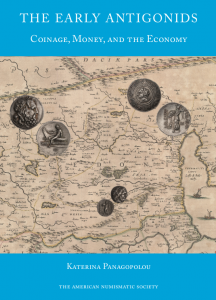 The Early Antigonids
The Early Antigonids
Coinage, Money, and the Economy
(Numismatic Studies 37)
by Katerina Panagopoulou
List price: $150 plus shipping & handling
Member price: $105 plus shipping & handling
ISSN 0517-404-x
ISBN 978-0-89722-355-3
Hardcover, 372 text pages, b/w figures and 64 plates
This systematic analysis of the gold and silver coinages of “King Antigonos” is intended to explore the nature of the Antigonid cash economy during the second and the third quarter of the third century BC. The author’s principal aim in reconstructing the precious metal coinage of “King Antigonos” is to comprehend the way in which the mints concerned functioned and to identify the major issues of the period. This helps us to answer questions such as, whether or not production was continuous; on which occasions/for which purposes the mints operated; where and why the coins produced circulated and what their value at the time was; finally, whether these issues outlasted their initiator, Antigonos Gonatas. The macroeconomic profile of Antigonid Makedonia during this period is completed by an attempt to quantify and to contextualize these Antigonid silver issues. Explanations other than military for the production of this coinage are explored and the chronology and the role of those silver coins issued posthumously in the name of Alexander that are currently assigned to the early reign of Gonatas are reconsidered. Finally, the geographical distribution of these Antigonid issues is reassessed.
Order this title from our distributor, Casemate Academic/Oxbow Books. ANS Members, use your discount code at checkout. Forgot the code? Email Emma Pratte, or call 212.571.4470 x117.
For more information, or to order, see:
The Early Antigonids (http://numismatics.org/store/antigonids/)
NEW BOOK: THE CRYPTONOTE BOOK
Tom Badley is an artist and banknote designer in England. He also worked for a time in the banknote department of Spink. On his web site he announced plans for a forthcoming book on physical cryptocurrency. Thanks to the Society of Paper Money Collectors' News & Notes August 6, 2019 for mentioning the site. While poking around I discovered this. See also another article later in this issue highlighting some of Tom's great work. -Editor
The first of its kind, The Cryptonote Book (working title) will be a searchable index of all cryptocurrency issued in cash-like form. It will list the manufacturers, circulation numbers, and the estimated collectable value of each item. The first edition is expected in 2020.
Expected for release in 2020, the Cryptonote Book will be the world’s first catalogue of cryptocurrency in physical form.
Modeled on banknote catalogues such as ‘The Banknote Book’ ..., The Cryptonote Book/Guide will aim to catalogue cryptocurrency wallets of cultural and collectable significance.
It will feature sharp color images, date of production, security features (if any), comments on design content, and as much background information as possible. Also listed would be any available price information, such as auction results.
It is hoped this book will aid the growing collector community of paper/physical cryptocurrency wallets, and offer a definitive overview of this niche where money, art and the future of finance converge.
To read the complete article, see:
THE CRYPTONOTE BOOK
(https://www.bitcoin-banknote.com/2019/06/22/the-cryptonote-guide/)
NEW BOOK: A LINKED OPEN WORLD
In April 2017 the Oxford Paris Alexander Project (OPAL) hosted a conference at the University of Oxford entitled “A Linked Open World: Alexander the Great, Transnational Heritage and the Semantic Web.” OPAL is designed to supplement and enhance the American Numismatic Society's PELLA project with additional data and an interpretative framework.
From an April 6, 2017 ANS Pocket Change blog post:
"Speakers from the ANS included Director of Data Science Ethan Gruber and Research Scientist Sebastian Heath, who both addressed the technical side of
ANS-based digital projects like PELLA and the sematic web, that is the intensive and deliberate interlinking of different types of knowledge on the web,
including, for example, numismatic, geographical and biographical data within a single website like PELLA. Also from the ANS was Peter van Alfen, who presented
one of the historical case studies."
I noticed this week that the conference proceedings have been published. -Editor
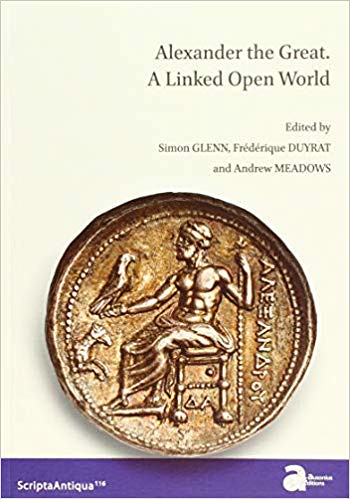 Alexander the Great : A Linked Open World
Alexander the Great : A Linked Open World
by Collectif (Author), Simon Glenn (Editor), Frédérique Duyrat (Editor), Andrew Meadows (Editor)
Publisher: Ausonius (29 Nov. 2018)
ISBN-10: 235613235X
ISBN-13: 978-2356132352
Product Dimensions: 24 x 1.4 x 17 cm
For more information, or to order, see:
Alexander the Great : A Linked Open World
(https://www.amazon.co.uk/Alexander-Great-Linked-Open-World/dp/235613235X)
As more and more numismatic information moves online the foundational concepts discussed in this conference will drive at least the academic world forward, but might also influence the commercial end of numismatics someday. Here's an excerpt from Sebastian Heath's paper. -Editor
Numismatics is a field of study that benefits from a well-developed vocabulary for describing both its basic concepts – such as “coin”, “mint”, or “hoard” – and the relationships between those concepts. Such an opening sentence must come, however, with the firm qualification that the definitions of numismatic terms and the realities of their usage are not always precise and consistent within the discipline. Nonetheless, it is the case that the vocabulary numismatics has at its disposal has been effective. By which I mean that as a centuries-old specialism, numismatics has made essential contributions to the study of the ancient Mediterranean world. This observation is true at the level of large-scale historical analysis and in the discussion of the role of coins in specific economic environments. For their part, the papers in this volume show the contribution that the study of coins can make to scholarship on a defined historical era, in this case the post-Alexandrian Hellenistic Kingdoms and neighbouring regions.
Clarity of language is nonetheless important and in the context of this particular chapter it is the terms “concept” and “relationship” that most need defining. By “concept” I mean the basic intellectual building blocks that comprise the field of study. “Coin”, “mint”, and “hoard” are among the concepts that will occur most frequently here; and while it is not the case that these concepts and others are so familiar that they can always stand without further discussion, such consideration is outside the scope of this paper given their fundamental role in the discipline. By very loose analogy, I take the concept of “coin” to be as axiomatic as numbers are in mathematics. We are confident they exist, even though there are many kinds.
Relationships, for their part, connect concepts. Numismatists express the connection between coins and mints in various ways. “Issued by”, “produced at”, even the very short “of” are common phrases to indicate the relationship between a mint and the coins associated with it; phrases, however, that surely highlight the issue of variable usage raised above. For its part, “mint” is an evidently useful, though very ambiguous, concept. It can mean the city in which a coin was struck, even if that city, by way of incorporation into a territorial state, is not necessarily the issuing authority. A more direct usage, by which “mint” is an attribute of a coin, is also common. Because this chapter is fundamentally about an aspect of digital numismatic practice, one can look to websites of public collections as a good indication of everyday usage, wherein this last use of “mint” is usual.
For more information, see:
PELLA IN OXFORD AND PARIS (http://numismatics.org/pocketchange/oxford-pella/)
Alexander the Great. A
Linked Open World, Scripta Antiqua n° 116, Ausonius, Bordeaux, 2018, 270 p. (https://www.academia.edu/38502432/Alexander_the_Great._A_Linked_Open_World
_Scripta_Antiqua_n_116_Ausonius_Bordeaux_2018_270_p)

REMEMBERING SIMON BENDALL
Anthony Portner submitted these thoughts on the late Simon Bendall. Thank you. -Editor
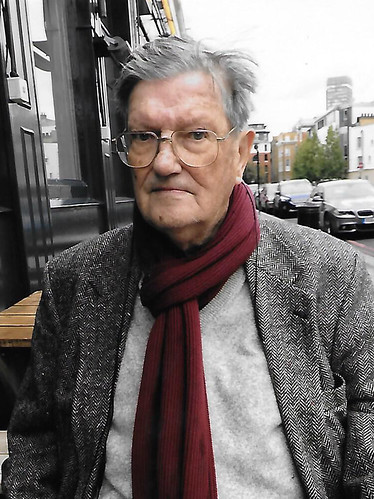 While not close as a fellow Byzantine
numismatist I was acquainted with Simon Bendall for forty years.I always found him willing to discuss matters patiently with a fellow enthusiast and would
describe him in Italo Vecchi’s words as a true gentleman and scholar.
While not close as a fellow Byzantine
numismatist I was acquainted with Simon Bendall for forty years.I always found him willing to discuss matters patiently with a fellow enthusiast and would
describe him in Italo Vecchi’s words as a true gentleman and scholar.
When my copper collection was stolen in 1980 he kindly provided the necessary certificate of value for the insurance company without payment.
When I was on the committee of the Royal Numismatic Society I persuaded the committee to make him an honorary fellow in view of his extensive work on the Palaeologan series. Indeed Philip Grierson in his introduction to volume V of the Dumbarton Oaks Catalogue of Byzantine coins describes his contribution to the study of the Palaeologan coinage to have been without parallel.
In December of last year I and my partner and other dealers dined with him. At that time he was clearly far from well but was still hoping to retire to the West Country.I last briefly saw him in early June at the coin fair at the Holiday Inn.
On Tuesday 6th August there was a service of commemoration at St Stephen’s Church Rochester Row which was extremely well attended.
Peter Clayton the well known egyptologist read the eulogy.
Afterwards we all adjourned to Simon’s favourite pub The Queen’s Arms Warwick Way where as Italo Vecchi has said “I am sure Simon was watching us from Coin Heaven'
Anthony also passed along Peter Clayton's eulogy - Simon the Numismatist. -Editor
Simon the Numismatist – a difficult word for many, but not for a large proportion of the congregation here present for Simon – numismatics means “the study coins”.
Simon was pre-eminent as a collector and scholar of Late Byzantine coins, the Byzantine Empire that continued in the East after the fall of the Western Roman Empire in AD 476 until its own fall to the Ottoman Turks at Constantinople on Tuesday, 23 October 1453.
I am a little older than Simon yet, curiously, our archaeological and numismatic lives ran on parallel lines over the years, and we had several friends in common.
Simon’s interest in coins was sparked when he was a pupil at Cheltenham College and he found a Roman coin in a local field (my first schoolboy purchases were two late Roman coins of Valens and Gratian at 6p each, a shilling the two (5p) from Woodiwiss, then in Victoria Street not far from here). After that one might say for Simon, “and the rest is history”. He became a collector, especially frequenting the antique shops in Cheltenham with their bowls of unidentified Roman coins: his interest lay in Imperial Roman coins, not the Republican series, noting in his autobiography that: “I have never been able to raise any enthusiasm” [for them].
After his two years National Service in the Royal Artillery he was in need of a job and joined H. J. Heinz in London, 1959-65. At the suggestion of John Casey (an old friend of us both from his days as an assistant librarian in the Institute of Bankers, and later FSA in 1976), he enrolled at the Institute of Archaeology, London University, for the four-year part-time course on archaeology, 1961-65. I had similarly enrolled in 1958 as one of the first students when the Institute moved from St John’s Lodge in Regent’s Park to Gordon Square. After the first three years, respectively on Prehistory, the Ancient Near East, and Bronze and Iron Age Europe, there were options for the fourth year – Simon chose Roman Britain and I Ancient Egypt, my first love since the age of eight. Simon went on to his numismatic career and I to mine as an Egyptologist, lecturer and author, and a career in publishing as an archaeological editor. We were both volunteering on various archaeological digs but never actually met but our parallel lines were to come together later. Simon’s interest in coins led to him being elected a Fellow of the Royal Numismatic Society (FRNS) in 1961, the requirement being an evident interest in ancient coins and the support of two existing Fellows. Subsequently he was elected an Honorary Fellow in 2010.
Seeking a job in numismatics, being very unhappy at H.J. Heinz, he and John Casey discussed Simon making an application to one of the big three prominent London coin dealers: Baldwins, Seaby and Spink. Simon was well known to all three as a collector with prominent numismatic knowledge. Baldwins he ruled out as at that time it was essentially a family-staffed firm; Seaby was dismissed as the head of ancient coins, Colonel Kozolubsky, a retired Polish cavalry officer, had recently died and a numismatist, David Sear, younger than Simon, had been appointed in his place, so Simon saw no chance of promotion. I well remember the Seaby advert in their Monthly Bulletin for a young man with an interest in ancient coins and who had completed his National Service. I fulfilled their requirements and had been tempted to apply. Fortunately for numismatics neither of us joined Seaby as David Sear went on to produce for Seaby the incredible series of books on individual coin series and their values – still in print in revised editions. They are now published under the Spink imprint since Seaby’s publications were sold - and that is where Simon and I were later to come together professionally after being friends for many years.
So, for Simon, Spink it was; interviewed by George Muller he was offered a job and became assistant in the ancient coin department. In 1967 Simon moved to Baldwins and was to remain there for 20 years, 1967-87. It was in those years that his interest and study of the later Byzantine coinage really took root, enrolling for a four- year evening class course on the series under Dr John Kent at Goldsmiths’ College, New Cross, London. It was in those years that Simon really began his extensive research and publications, he wrote over 200 articles published in major journals such as The Antiquaries Journal, The Numismatic Chronicle (journal of the Royal Numismatic Society); Revue Numismatique: Schweitzer Münzblätter, etc, together with several major books. Amongst them was The Billon Trachea of Michael VIII Palaeologos 1258-1453 (1974), and The Later Palaeologon Coinage 1282-1453 (both with Peter Donald, 1974). His book An Introduction to the Coinage of the Empire of Trebizond (also with Peter Donald, 1979) was the first book in over 100 years on the subject since the British Museum catalogues by Wroth and Retowski in 1908 and 1911.
In 1977 Simon married his American wife, they had met when she was studying archaeology in London. Her homesickness for the USA led him to seek a numismatic job there, which he obtained and joined Numismatic Fine Arts (NFA) in Los Angeles in November 1987. It was shortly after he had gone to NFA that he published A Private Collection of Palaeogon Coinage (actually the coins in his own collection). The book was dedicated to Dr F. A. Linville, a private collector who had financed it and it was marketed through NFA.
Simon was always generous in sharing his knowledge and expertise with others. In Vol. V. of the Catalogue of the Byzantine Coins in the Dumbarton Oaks Collection and in the Whittemore Collection. Michael VIII to Constantine XI, 1258-1453 (published in 2006), Professor Phillip Grierson recorded how Simon had spent August 1980 with him in Dumbarton Oaks, when, “my work was checked and where necessary corrected by Simon Bendall whose knowledge of the series is unrivalled” – there can be no higher accolade than that!
Recognised as an acknowledged authority on late Byzantine coins Simon was proposed as a Fellow of the Society of Antiquaries of London (FSA, founded 1707) in November 1985. This was no straight forward election as with the RNS. The initial sponsoring Fellow had to acquire a “Blue Paper” from the General Secretary and submit it with full details and qualifications of the proposed candidate for approval by the Council. That hurdle passed, it was then required that at least eight Fellows should sign as sponsors from “Personal Knowledge.” Simon’s initial sponsor gathered 11 other signatories, many of them prominent numismatists including Professor Phillip Grierson (medieval coins); Christopher Blunt (Anglo-Saxon coins); Ian Stewart (later Lord Stewartby, Scottish hammered coins); Dr John Kent (Roman coins) and others. Then the candidate’s name and details were circulated to Fellows and then went to a secret ballot at a Society meeting, voting in 18th century ballot boxes casting a small cork ball for “Yea” or “Nay”. Every “Nay” vote cast cancelled out four “Yeas” – this meant that a 75% overall vote was necessary for election. Simon was successfully elected and remained a Fellow for 34 years until his death. Of the original 12 signatories from “Personal Knowledge”, only two of them are still alive: Robin Porteous whom I saw a few months ago, and me.
Simon’s wife’s homesickness for her East Coast origins grew – NFA was on the West Coast, and a return was made to London. Simon decided to become self-employed as a numismatic consultant, cataloguer of collections and auctions, and writer. Although he nominally retired in 2010 he continued publishing many articles.
It was in 1980 that I left the British Museum as its Managing Editor and was invited to join Seaby, Numismatists to HM The Queen, as an Associate Director to set up an antiquities department and take their publications list further, publishing revised editions of older books, editing and commissioning new titles. Thus it was that Simon’s career as a professional numismatist and mine as a publisher and archaeological editor, came together. Gavin Manton was now head of the Ancient Department at Seaby and David Sear had gone to NFA.
The first edition of Byzantine Coins & Their Values had been published in 1974 and it was decided to produce a second revised and enlarged edition by David Sear in 1987, and Simon agreed to assist as the co-author. Michael O’Hara had been working on identifying fake Byzantine coins and I suggested to David and Simon that I should ask him to contribute that work as an Appendix. They were both in agreement, as was Michael, and Simon carefully checked the text. After the detailed Introduction, 2645 coins are listed and described: the book still stands as the immediate vade mecum to the series even after all these years.
In February 2018 Simon suffered a grievous loss when burglars knocked down the front door of his house in Chelsea and stole his huge major reference collection of late Byzantine coins, plus medals, tokens and antiquities. The police opinion was that it was a “targeted” burglary, particularly by the nature of the items stolen. Such a large collection of Late Byzantine coins would be a problem in the market. I recall a similar burglary many years ago, that of the Anglo-Saxon coin collection of F. Elmore Jones. The coins disappeared and several years later when the strong box of a murdered East London gangster was opened there was the Elmore Jones collection, complete. If Simon’s coins have not been spirited abroad there are hopes perhaps that one day history may repeat itself and they will reappear.
Simon had been taking an interest in bronze and glass Byzantine weights and wrote a text: Byzantine Weights: An Introduction. I edited and produced it and it was privately printed. Although only 68pp it illustrated 207 weights and has a valuable Appendix of drawings of the monograms that appeared on the glass weights. It is a seminal work of enormous value, but often missed in the list of Simon’s publications.
But, finally, to return to Simon’s love of bright colours and my taking the Institute’s fourth year on Ancient Egypt and a career as an Egyptologist and archaeological editor - hence my tie featuring the Egyptian falcon god Horus. On many large stele inscribed with the details of the deceased’s life, the hieroglyphic text often opens with the prayer: “Speak my name that I may live”. Simon’s name will be spoken with love in the family but in the world of the study of Late Byzantine coins when a query is raised the immediate reply is going to be: “Check it out in Bendall”, both now and by future collectors and students. The prayer will be answered: Simon’s name will be mentioned and he will live on.
An eulogy delivered on Tuesday 6th August 2019 at St Stephen’s Church, Rochester Row, Westminster, London, by Peter A. Clayton, FSA, FRNS.
To read the earlier E-Sylum articles, see:
SIMON BENDALL (1937-2019) (https://www.coinbooks.org/v22/esylum_v22n30a10.html)
NOTES FROM E-SYLUM READERS: AUGUST 4, 2019 : Remembering Simon Bendall
(https://www.coinbooks.org/v22/esylum_v22n31a14.html)
HERITAGE BULLET SALES ON NEWMAN PORTAL
The latest addition to the Newman Numismatic Portal is a run of the Heritage Auctions “Bullet” Sales. Project Coordinator Len Augsburger provided the following report. -Editor
Heritage Auctions “Bullet” Sales on Newman Portal
 Auction houses have long understood the need for multiple brand names, with premier material flowing to
the frontline sales and more collectible items routed to a “collector” brand. In the case of Heritage Auctions, the Bullet sales from 1989 – 2005 represented
an outlet for more accessible items. These printed catalogs filled the U.S. postal system and most collectors who were active in this period well remember the
black-spined, card cover format and summary listings of thousands of U.S. coins.
Auction houses have long understood the need for multiple brand names, with premier material flowing to
the frontline sales and more collectible items routed to a “collector” brand. In the case of Heritage Auctions, the Bullet sales from 1989 – 2005 represented
an outlet for more accessible items. These printed catalogs filled the U.S. postal system and most collectors who were active in this period well remember the
black-spined, card cover format and summary listings of thousands of U.S. coins.
The Bullet sales represent a unique period in American numismatics, one in which sales activity was increasing, but without ubiquitous Internet service. Once the web was widely accessible, printed copies of these catalogs were no longer practical. Today, the Bullet sales have migrated into the Heritage weekly Internet sale, which is 100% electronically-based. Thanks to a donation by the estate of Phil Carrigan, the Newman Portal has been able to digitize approximately a hundred of the Bullet sale catalogs, and these are now available for reference. Newman Portal acknowledges Heritage Auctions for granting permission to scan these.
Link to Heritage Auctions Bullet sales on Newman Portal:
https://nnp.wustl.edu/library/auctioncompanydetail/513009
VIDEO: 2019 SUMMER FUN: TREASURE TRIVIA
These are selections from the David Lisot Video Library that feature news and personalities from the world of coin collecting. David has been attending coin
conventions since 1972 and began videotaping in 1985. The Newman Numismatic Portal now lists all David’s videos on their website at:
https://nnp.wustl.edu/library/multimediadetail/522852
Here's one on Summer FUN Treasure Trivia -Editor
“Treasure Trivia” at Summer FUN Inspires New Kid Collectors.
VIDEO: 2:52.
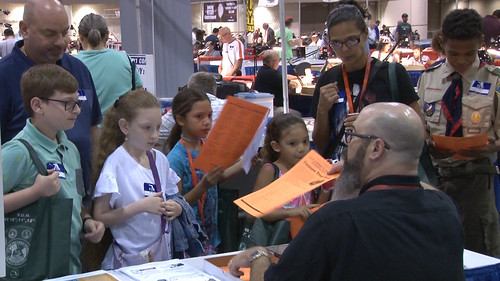 Sam Gelberd, Numismatic Educator, American Numismatic Association, David Lisot, Interviewer,
CoinTelevision.com.
Sam Gelberd, Numismatic Educator, American Numismatic Association, David Lisot, Interviewer,
CoinTelevision.com.
The Florida United Numismatists has a young numismatists program targeting kids of all ages. A representative of the American Numismatic Association, Sam Gelberd, helped with the program and shares what FUN and ANA do to inspire kids to get into coin collecting.
An excerpt of the video is available for viewing on the Coin Television YouTube Channel at:
https://youtu.be/mSIN8ygaUAE
This video is a highlight from FUN Summer Coin Convention Highlights 2019
ARTICLE EXAMINES SS CENTRAL AMERICA COIN RUST
Bob Evans is the chief scientist of the S.S. Central America shipwreck project and a frequent E-Sylum contributor. He's writing this week to announce a scientific article about rust on shipwreck gold coins. The Interpretation of Biogeochemical Growths on Gold Coins from the S.S. Central America Shipwreck: Applications for Biogeochemistry and Geoarchaeology is now available in the peer-reviewed online Journal of Marine Science and Engineering. -Editor
I am delighted to announce the publication of our peer-reviewed article about biogeochemical growths ("rust" to non-scientific folks ) on gold coins from the S.S. Central America treasure. For those of you who regard rust as simple and dirty, this article will do its best to change your minds.
With my background as a geologist, early on in the SSCA project I became fascinated with the environmental processes of shipwreck degradation, corrosion and re-deposition of mineral deposits on the coins and ingots. The rust fascinated me from the very first moments we saw the shipwreck on our monitor screens in 1988. At that time there was nothing in the literature about rust on gold. Why would there be? Gold doesn't rust. But in the very unusual chemical and biological environment of a wooden-hulled steamship festooned with gold deposits, such quirks of nature are actually commonplace. Bacteria play a major role in the formation of such deposits. In this study my co-authors and I explore and analyze the different microscopic layers of a typical rust-on-gold deposit that flaked off a double eagle. This seemingly innocuous flake of rust became the subject of an excellent Senior Thesis (by Bryan Seymour, one of my co-authors for the article) and related geological study performed using a scanning electron microscope and associated scientific tools.
A fortuitous meeting: Professor Erik Melchiorre of California State University San Bernardino came to see the Ship of Gold exhibit at the Long Beach Coin & Collectible Expo in February of last year. I saw him looking at the gold with his kids, spending more than the usual amount of time in front of the porthole-like display of gold nuggets and gold dust. Most people focus on the gleaming displays of ingots and mint-state gold coins. There was a lot of that on display. But we also found whole bags (pokes) of gold dust and nuggets during the 2014 recoveries. As I engaged the pony-tailed professor in conversation I immediately realized that he understood the deeper significance of what was on display, geological samples from a specific year of the California Gold Rush. This allowed us to ask questions such as, "Exactly where were they mining in 1857?" -- the kinds of possibilities that appeal to those who read the stories in the earth. There are chemical, mineralogical and crystallographic clues spread throughout these very special samples of rocks, sand and dust. Under very high magnification and subject to modern scientific techniques, the secrets have begun to reveal themselves.
We have studies addressing the mineralogy of the gold itself, but have also expanded into the clues presented by microscopic grains of other minerals found associated with the gold dust. These topics address the geology of the gold and its origins in California.
Additional opportunities for research come from the shipwreck itself, a geological environment with its own suite of wonderful scientific phenomena to discover and investigate. This article is one of the fruits of that type of investigation. As the chief scientist of the shipwreck project and the curator of the treasure I have dealt with "rust" in a wide variety of forms on gold and other objects for 30 years. It pleases me very much that we are gaining a greater understanding of the incredible complexities involved in such a "simple" substance.
Thanks, Bob. I'll have to admit the word "biogeochemical" makes me think of "Vitameatavegamin," the fictitious health tonic promoted on the classic "I Love Lucy" TV episode. I'd never heard that scientific name for rust. But it's an important topic and I'm glad to learn the paper has been published. Here's a short excerpt, but readers can delve into the whole thing online. -Editor
Abstract: Black crusts that formed on gold coins recovered from the 1857 shipwreck of the SS Central America played a key role in their preservation in a near original state. Within a few years of the sinking, the significant quantities of iron and steel on the shipwreck produced laminar geochemical precipitates of fine-grained iron minerals on the coins. This coating served to armor the coins from future chemical or biological attacks. Once coated, the coins were colonized by at least two distinct populations of gold-tolerant bacteria that precipitated abundant nanoparticulate gold in the black crust material and produced biomineralized bacteria in a web-like mat.
Above this middle layer of black crust, the outer layer consisted of a geochemical reaction front of euhedral crystals of iron sulfate and iron oxy-hydroxide species, formed by the interaction of seawater with the chemical wastes of the bacterial mat. Understanding this process has application for assessing the diverse and extreme conditions under which nano-particulate gold may form through biological processes, as well as understanding the conditions that contribute to the preservation or degradation of marine archaeological materials.

Figure 4. Image of an 1857-San Francisco mint $20 gold coin from the shipwreck, showing the preserved cast of the coin on a fragment of black crust (red box). The image of the crust has been inverted to align with the coin, as it is a negative-relief cast. The yellow areas on the crust are not gold, but hydrated iron oxides. Coin image courtesy of Professional Coin Grading Service.
To read the complete article, see:
The Interpretation of Biogeochemical Growths on Gold Coins from the SS Central America Shipwreck:
Applications for Biogeochemistry and Geoarchaeology (https://www.mdpi.com/2077-1312/7/7/209/pdf)
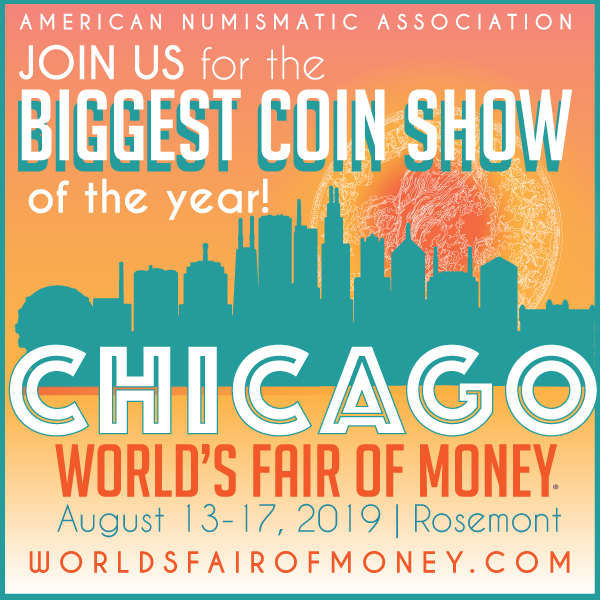
MORE ON RESEARCHER "NIEL" NIELSEN
Herb Friedman submitted these notes on paper money researcher Niel Nielsen. -Editor
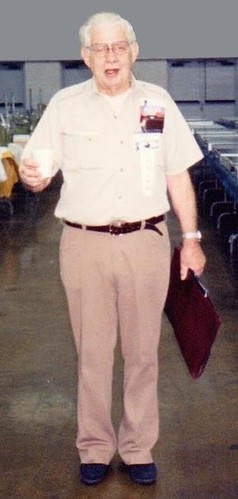 I knew him for about 30 years and we wrote
on a regular basis. Howard mentioned cigarettes but that was not a cigarette. He smoked really nasty cigars. Sometime when you visited him you sat outside his
screen door while he sat just inside and smoked. If he sent you a letter, you took it outside and hung it on a clothesline to air out.
I knew him for about 30 years and we wrote
on a regular basis. Howard mentioned cigarettes but that was not a cigarette. He smoked really nasty cigars. Sometime when you visited him you sat outside his
screen door while he sat just inside and smoked. If he sent you a letter, you took it outside and hung it on a clothesline to air out.
He was merchant marine during the war and much of his collection was built by sailing from one port to another and just buying as he went. I have a lot of his personal books and they sometimes took a year or two to get the stink out of. Having said all that, he was a hell of a researcher. I was writing a series of about 30 articles for the IBNS and other magazines in those days and we would fight and debate over things. Even now when I buy some of Niel's lots from Cookie Jar I find some of my old letters and articles in his files. His strength was the Philippines and China. He was pretty good on Vietnam too.
Sometimes he would send me stuff and ask me to write an article and I would tell him there was not enough data and then he would get mad and sulk for a while. But, he was a great guy to know and you could learn a lot listening to him.
Thanks. Below are links to all the older articles on Nielsen. -Editor
To read the earlier E-Sylum articles, see:
C. M. NIELSEN, PHILIPPINE GUERRILLA CURRENCY RESEARCHER
(https://www.coinbooks.org/esylum_v11n33a13.html)
CONRAD MOWER NIELSEN (1922-2008) (https://www.coinbooks.org/v20/esylum_v20n19a13.html)
PHILIPPINE PAPER MONEY RESEARCHER "NIEL" NIELSEN
(https://www.coinbooks.org/v22/esylum_v22n31a18.html)
NOTES FROM E-SYLUM READERS: AUGUST 11, 2019
Dick Johnson Recovering
Author, researcher and longtime E-Sylum contributor Dick Johnson has been sidelined with some medical issues. I spoke with his wife Shirley this week and she reports that he's doing well and has some idle time in his care facility. -Editor
Shirley writes:
"He has gotten books from Library of Congress that he can listen to and enjoys receiving all the cards and notes anyone sends. Cards can be sent to me at home and I will deliver them to him: Shirley Johnson, 139 Thompson Drive, Torrington, CT 06790. E-mails can be sent the normal way, to dick.johnson@snet.net ."
Dick's turning 89 this month. Tell him what you like about his columns, ask a question, or just drop a note or card to say hello. He'll be glad to hear from you. -Editor
FERTILITATEM DIVITIAS QUE CIRCUMFERREMUS
Last week Dave Bowers asked for help on the meaning or translation of the inscription FERTILITATEM DIVITIAS QUE CIRCUMFERREMUS on the obverse of the 1794 Copper Company of Upper Canada halfpenny. I looked for an image that most plainly shows the legend, and found this aluminum restrike in the Heritage January 2017 NYINC Signature Sale, Lot 34136. -Editor
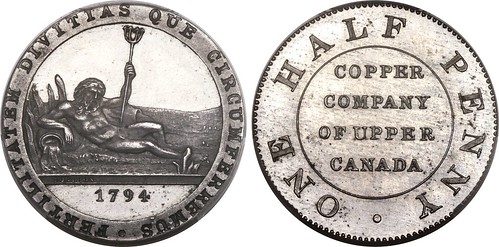
The "que" in this legend should be tacked onto Divitias as a suffix, and means "and" here. I read it as "let us spread abundance and wealth". The tense of the verb could be open to discussion - others with better Latin than mine might be able to improve on this.
Thank you! -Editor
To read the earlier E-Sylum article, see:
QUERY: TWO ENIGMATIC TOKEN INSCRIPTIONS
(https://www.coinbooks.org/v22/esylum_v22n31a13.html)
Buy the note, Not the Label
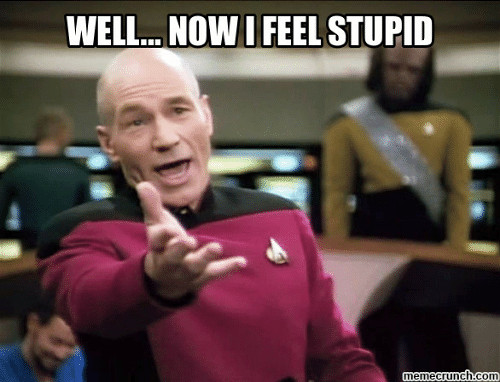 Regarding the hobby
dependence on third party graders, Tony Terranova writes:
Regarding the hobby
dependence on third party graders, Tony Terranova writes:
The very simple solution is to self teach yourself about what you collect. AKA "Buy the Note, not the label".
To read the earlier E-Sylum article, see:
WHEN INSTITUTIONS FAIL: PART II (https://www.coinbooks.org/v22/
esylum_v22n31a22.html)
Did Frank Lapa Get Out of Prison?
Paul Bosco writes:
Last week, Bob Leonard wrote about Frank Lapa dying in prison. I'm certain he did not. Chicago exonumist Ben Odesser once told me someone caught up to him on the street and said "Ben, it's me, Frank." Lapa did not live a long life and I don't know of any numismatic activity after his release. There is much in The E-Sylum about him, in the first issue for 2003.
Bob Leonard of Chicago writes:
I knew Ben Odesser well and I never heard from him that Frank Lapa was released early. I think Paul is confused about this. Lapa was convicted of murder in California. I found a news item from the Santa Cruz Sentinel (July 28, 1978) showing that Lapa was sentenced to life in prison. I do not find anything showing that his sentence was commuted or that he escaped.
Thanks. Here are some links to earlier articles about Lapa. -Editor
To read the earlier E-Sylum articles, see:
LAPA COUNTERFEITS (https://www.coinbooks.org/esylum_v05n52a07.html)
FRANK LAPA (https://www.coinbooks.org/esylum_v06n01a12.html)
LAPA MURDER CASE (https://www.coinbooks.org/esylum_v06n29a20.html)
https://www.coinbooks.org/esylum_v09n31a32.html (https://www.coinbooks.org/esylum_v09n31a32.html)
NOTES FROM E-SYLUM READERS: AUGUST 4, 2019 : "The Coins Tone Themselves"
(https://www.coinbooks.org/v22/esylum_v22n31a14.html)
More on Safe Deposit Box Safety
Vic Mason writes:
 I had wanted to respond to this
issue earlier: the risks of bank safe-deposit boxes. Len Augsburger referenced a long piece by Stacy Cowley in the Sunday, 21 July 2019, New York Times,
entitled: “Safe Deposit Boxes Aren’t Safe.”
I had wanted to respond to this
issue earlier: the risks of bank safe-deposit boxes. Len Augsburger referenced a long piece by Stacy Cowley in the Sunday, 21 July 2019, New York Times,
entitled: “Safe Deposit Boxes Aren’t Safe.”
Exactly a decade ago, during the great financial crisis, Long Island friends of mine were on an extended summer vacation in Italy. Their bank had recently been taken over by a stronger institution, and while they were gone, thieves somehow got into their bank safe-deposit box and stole an estimated $200,000 worth of precious metals. My friends, calling it “an inside job,” notified the local police, who notified the FBI. Of course, the property was never recovered and the case was never solved. My well-off friends chose not to sue, on the advice of their lawyer.
My friends, perhaps embarrassed, did not tell me about their loss until 1½ years later. Shortly thereafter, in response to something related in its 25 December 2010 edition, I wrote to The New York Times that Christmas Day to ask how common such thefts are in this country. From then until now, The Times did not publish anything on this subject. And it did not publish or respond to my letter.
Such thefts from American banks’ safe-deposit boxes are evidently quite rare. The Cowley piece says: “Of the 19,000 bank robberies reported to the FBI in the last five years, only 44 involved safe-deposit heists.” However, she quotes a Chicago-based industry expert whose firm provides insurance for bank safe-deposit boxes as “estimat[ing] that around 33,000 boxes a year are harmed by accidents, natural disasters and thefts.”
Speaking a decade ago with acquaintances at my local branch of JP Morgan Chase, I learned that American banks will not cover the loss of two things stored in the safe-deposit boxes: cash or bullion. That’s easy to understand. Cowley reports that, even then, JP Morgan Chase will cover the contents of a safe-deposit box only up to a total value of $25,000; Wells-Fargo, up to just $500; Citicorp, only up to “500 times the box’s annual rent”; and Bank of America, only up to “ten times the annual rent charged for the box.” Cowley says our largest banks find the boxes more trouble than they are worth and “rarely install them in new branches” any more.
In recent years, my bank has significantly tightened its security procedures for letting customers into their safe-deposit boxes. But one of the most reassuring steps that customers can always take in their own interest is to be certain that bank staff know them well, to know the bank employees’ names, and to always be friendly and courteous towards them. The appreciation can then go both ways.
I suspected these events were rare, and it makes sense that risks greatly increase whenever there's a change in bank ownership. -Editor
To read the earlier E-Sylum article, see:
SAFE DEPOSIT BOXES AREN'T SAFE (https://www.coinbooks.org/v22/esylum_v22n30a27.html)
1792 Silver and Non-Silver Center Cents Follow-Up

Maureen Levine writes:
Two pieces regarding the 1792 Morris so-called Silver Center Cent have been posted to the Newman Numismatic Portal.
The selected responses and call to action are posted at:
1792 Morris So-Called Silver Center Cent Research Presentation: Responses and Call to Action
(https://nnp.wustl.edu/library/book/567274)
The numismatic community responses are posted at:
1792 Silver And Non-Silver Center Cents: Responses from the Numismatic Community
(https://nnp.wustl.edu/library/book/567273)
The articles by Stu Levine are a follow up on analysis of the Morris example of the so-called silver cent (1792 Judd-1). -Editor
To read the earlier E-Sylum articles, see:
1792 SILVER AND NON-SILVER CENTER CENTS STUDY
(https://www.coinbooks.org/v20/esylum_v20n48a18.html)
1792 SILVER AND NON-SILVER CENTER CENTS UPDATE
(https://www.coinbooks.org/v22/esylum_v22n26a05.html)
Query: ANA Formation Meeting at Columbian Expo?
Dave Bowers writes:
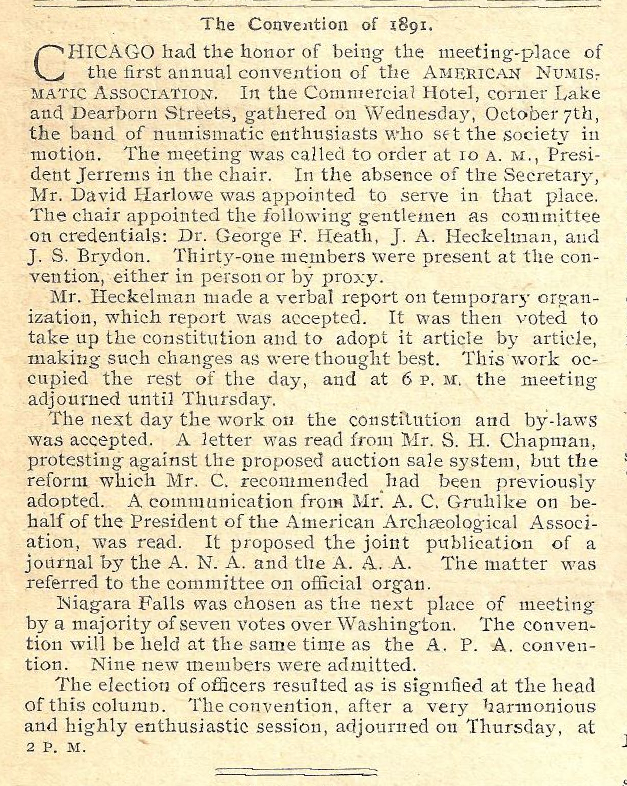 I am putting the
finishing touches on a book I am doing relating to the World’s Columbian Exposition. Geo. F. Heath, M.D. called for a meeting at the Commercial Hotel in
Chicago, October 7, 1891, to discuss formation of the American Numismatic Association. This was accomplished that day and on the 8th with about 30 people
represented in person and by proxy. Officers and the board were elected.
I am putting the
finishing touches on a book I am doing relating to the World’s Columbian Exposition. Geo. F. Heath, M.D. called for a meeting at the Commercial Hotel in
Chicago, October 7, 1891, to discuss formation of the American Numismatic Association. This was accomplished that day and on the 8th with about 30 people
represented in person and by proxy. Officers and the board were elected.
I recall reading some details of the contingent visiting the site of the WCE then under construction. These details are not in The Numismatist.
My query: Does anyone have any correspondence or other information on this?
Another possibility is that Dr. Heath, who loved to write, shared his experiences in a local or regional newspaper. He lived in Monroe, Michigan.
This is trivia par excellence, but I have always enjoyed details. I look forward to seeing some of you at the World’s Fair of Money.
No detail is too small for a numismatic infomaniac. Can anyone help?
Joel Orosz found Charles Taylor Tatman's report (pictured) on the first ANA meeting published in the November 1891 issue of Plain Talk (a predecessor of The Numismatist. It did not mention a visit to the Exposition. Is this information to be found elsewhere in numismatic literature? -Editor
FACT-CHECKING THE INVENTION OF MONEY
PAN & ANA life member Tom Corey writes:I believe Sweden issued the first paper banknotes from the Stockholms Banco, not England.
Tom's not the only one to have issues with the New Yorker article we discussed last week, although it wasn't claiming that paper money was invented in England - the article opens with a discussion on paper money use in China centuries before the creation of the Bank of England.
The August 6, 2019 News & Notes from the Society of Paper Money Collectors mentioned an article by economist Joakim Book on the site of the American Institute for Economic Research headlined "Egregious Errors in The New Yorker’s Account of Financial History." -Editor

Bank of England
Using history to shed light on present issues is trendy and tempting. But poor grasp of said history instead makes one’s reasoning embarrassing and inadequate.
In the upcoming issue of the New Yorker, John Lanchester writes a long-form essay misleadingly titled “The Invention of Money,” where he attempts precisely this: to weigh in on current questions about money and cryptocurrencies by looking at the financial and monetary past. Let’s just politely say that he underperforms.
Lanchester is initially concerned with questions about what money is and how money "derives its value" — especially in regard to established cryptocurrencies such as Bitcoin and new initiatives such as Facebook's Libra. He bundles that interest with a very confusing — and mostly misleading — account of the early history of the Bank of England. And it does very little to shed light on questions of money.
There's a dissonance in Lanchester's error-filled essay, where the first third raises questions about money's value. If Lanchester is interested in those questions, he is more than welcome to peruse the readings we assigned our students attending the Harwood Graduate Colloquium this week. That should straighten out most of his confusion.
I won't get in the middle of a footnote-slinging battle between two authors, but here are links to the full pieces. The AIER article contains links to supporting material. -Editor
To read the complete articles, see:
Egregious Errors in The New Yorker’s Account of Financial
History (https://www.aier.org/article/egregious-errors-new-yorkers-account-financial-history)
The Invention of Money
(https://www.newyorker.com/magazine/2019/08/05/the-invention-of-money)
To read the earlier E-Sylum article, see:
THE INVENTION OF MONEY (https://www.coinbooks.org/v22/esylum_v22n31a31.html)

RICHARD STOCKLEY BOOKS AT 2019 RCNA SHOW
In May we reported on Canadian Howard Engel's acquisition of the numismatic literature business of Richard Stockley. Howard's doing well and provided this report for E-Sylum readers on his recent trip to the RCNA show. -Editor

Howard Engel setting up on July 17, 2019 prior to the show opening
I just came back from my inaugural show at the Royal Canadian Numismatic Association (RCNA) Convention in "Cow Town", Calgary, Alberta (July 16-20) and I'm most pleased with the results. Not only did I cover my considerable costs, I also paid for a $2375 balance I owed Richard Stockley for the books he had purchased from a collection in Calgary that we agreed should remain there as part of my show stock.
Even with these expenses taken into account, I still cleared a four-figure profit. This is testimony to pent up demand since it had been 2 years since Richard attended the RCNA and he had never come out to Western Canada. Thus, all stock, whether new or old was new to those who attended the Calgary show. Most importantly was making myself known and networking. I added no fewer than 40 more names to my already substantial roster of 140 customers. I'm still designing/producing my business card.

Howard R. Engel flanked by previous owners, Richard Stockley (left) and his wife Deirdre Crevier (right)
I brought 22 boxes of books in my 2-seat Rav 4 (I took out the back seats) and picked up another 10 boxes from three sources, including culls from the Canadian Numismatic Association Library that is domiciled in Edmonton, Alberta. Since I sold the equivalent of 3 boxes, I ended up taking 29 boxes back to Winnipeg with me where they now reside in the storage facility I'm renting for my business. In addition to the training week in Winnipeg from June 17 to 24, Richard mentored me at the show, while saying good-bye to many dealers and other customers he and his wife Deirdre got to know over the many years they attended shows.
One complicating factor is that my vehicle, a 2004 Rav 4 with less than 93,000 original km or about 58,000 original miles was sideswiped while parked at my cousin's farm about an hour northwest of Edmonton, near Dapp, Alberta. Having driven all the way to Calgary to attend the show, I did not want to miss out on this opportunity to see my cousins in northern Alberta on my way back. Since I'm a recently retired Library Technician from Red River College, I now have the time to make such side trips.
Preoccupied with making hay, on the second day of my stay, my cousin's husband forgot where I was parked. The accident meant I could not open my door but enter and exit from the passenger door. While I had used the passenger seat to house my "closet" style suitcase, I could not simply move it to the back as it would obstruct my vision. I exchanged the suitcase for a duffel bag they happened to have on hand and all was well as the duffel could be squished flat, unlike the rigid suitcase. Thankfully, the collision did not affect my vehicle mechanically nor safety-wise in that my headlamp, signal light, tire, steering, hood nor side mirror were affected so it was still drive-able.

Paul Johnson, Executive Secretary of the RCNA (left) and Clifford Mishler, official representative of the ANA at the RCNA (right) looking through stock
I have all but ruled out attending U.S. shows as a numismatic book dealer due to issues with customs and tax reporting (I've heard horror stories from other dealers who recommend that it's not worth the hassle). Unlike in Canada, where I've cornered the market as the sole numismatic book dealer, in large U.S. shows like the ANA I would have stiff competition from Kolbe and Fanning and/or Charles Davis. Of course, this does not preclude me from attending U.S. shows as an interested individual and hobbyist. I have more reason to think of doing so since I've just decided to take out a life membership in the ANA. Unfortunately, I have not planned to attend the ANA Convention next week in Chicago (which, at about 12-hours one way, would have been a slightly shorter drive than the one I have just made to Calgary).
Yours in numismatic literature,
Howard
Thanks for the update, Howard! Welcome to the ranks of numismatic literature dealers. Information is the backbone of a hobby like ours, and I'm glad to see the healthy demand. Howard can be reached at: richardstockleybooks@mymts.net . -Editor
For the complete Flickr gallery of Howard's trip photos, see:
2019 RCNA Richard Stockley Books
(https://www.flickr.com/photos/coinbooks/albums/72157710242840821)
To read the earlier E-Sylum article, see:
HOWARD R. ENGEL ACQUIRES RICHARD STOCKLEY BOOKS
(https://www.coinbooks.org/v22/esylum_v22n21a08.html)
VOCABULARY TERM: REDUCTION PUNCH
Dick Johnson submitted this entry from his Encyclopedia of Coin and Medal Terminology. Thanks! -Editor
Reduction Punch. A patrix or hub cut on a die-engraving pantograph; it may contain all design and lettering, but more often was the device alone. The reduction punch was particularly used in diesinking at a time when early pantographs were adequate to cut portraits (or other devices) but were inadequate to cut lettering or detail particularly near the border of a coin or medal design. What the reduction punch accomplished then, was a marriage of early machine engraving with existing hand engraving – with the machine cutting the device and hand working the lettering by engraving or punches.
Reduction punches were first used early in the 19th century when fixed-cutter pantographs – notably those of Dupeyrat and Wohgemuth in France, those of the Soho Mint and the Royal Mint in England, and several others elsewhere – were capable of cutting an acceptable portrait. The device was modeled, cast in some hard metal for the pattern, then reduced by the pantograph cutting a hub the intended size needed.
Instead of completing the full design in the model and reducing this to the size die required, here was the sequence necessary: (1) model the device, (2) cast or electroform a pattern of the device, (3) cut a reduction punch of the device on a pantograph from the pattern, (4) hub the reduction punch into a die, (5) add the lettering by hand punches or hand engraving to complete the die.
While these extra steps added time and cost, using reduction punches had the advantage, however, of reducing, say, a monarch's portrait for several size coins. The lettering could be different for each denomination, but the portrait would be the same design in differing sizes.
The next generation pantographs –Caque in France, C.J. Hill in England – had rotating cutters, in effect a milling machine. This improvement overcame somewhat the shortcoming of previous pantographs. But it was not until the 1890s that the quality of the pantographs was such that they could cut the entire die at one time from a pattern that contained all the design, lettering, everything. Thus the need for the reduction punch became unnecessary after this advancement in die making.
Looking for the meaning of a numismatic word, or the description of a term? Try the Newman Numismatic Portal's Numismatic Dictionary at: https://nnp.wustl.edu/library/dictionary
Or if you would like a printed copy of the complete Encyclopedia, it is available. There are 1,854 terms, on 678 pages, in The Encyclopedia of Coin and Medal Technology. Even running two a week would require more than 19 years to publish them all. If you would like an advance draft of this vital reference work it may be obtained from the author for your check of $50 sent postpaid. Dick Johnson, 139 Thompson Drive, Torrington, CT 06790.
MAX HEILBRONNER (1848-1906)
Max Heilbronner (1848-1906), was born in, Germany, son of Abraham and Sarah Heilbronner, Jewish workers in the garment industry that came to America in 1872.
He began dealing in coins about the same time as Lyman Haynes Low. The two dealers may have known one another for the remainder of Heilbronner's life since he consigned materials to him in 1905 to sell at the final H. G. Brown sale.
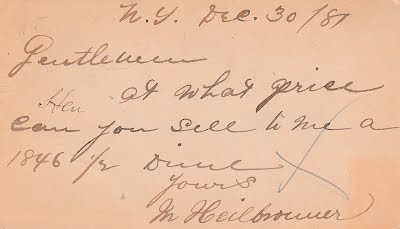
He is listed as a coin dealer in the 1884 New York City Directory, 310 West 4th Street, New York.
On June 30, 1889, he married Lena Meyer.
In 1889, he appears to be working in the New York garment industry at 50 8th Avenue as a worker of trimmings.
In 1897, he is listed as a dealer of fancy goods 79 Avenue B, this was a common job title given to curiosity shop owners, as well as stamp and coin dealers. He remained at this address until 1902.
On April 19, 1905, Lyman Haynes Low sold the last part of the H. G. Brown collection and a few others including Heilbronner.
He died in November 1906 and was buried on the 4th in the Maimonides Cemetery, Brooklyn, New York.
To read the complete article, see:
HEILBRONNER, MAX
(https://sites.google.com/a/numismaticmall.com/www/numismaticmall-com/heilbronner-max)
The entire inventory of the Lupia Numismatic Library is for sale. Individual items will be available before the remaining archives are broken up into parcels sold at philatelic auctions in the U. S. and Hong Kong. Check NumismaticMall.com frequently as dozens of new items with estimates will be posted daily until everything is sold.
All inquiries will be given prompt and courteous attention. Write to: john@numismaticmall.com .
HARVEY STACK'S NUMISMATIC FAMILY, PART 50
The latest article in Harvey Stack's blog series focuses on the R.L. Miles Collection exhibit. Here is part 50. Thanks, Harvey. -Editor
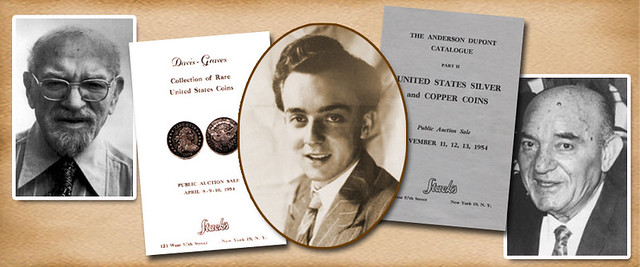
Right after the first of the year, the Bank opened its new building with the R.L. Miles Collection on display. It attracted thousands of visitors for the first 30 days it was open. Another highlight of the exhibit was the display of The Mace of Baltimore, the symbolic Mace given to the governor of the Colony, which indicated he had the royal power from the King of England.
The Mace was stored in a deep vault by the bank which, when on display, came from its deep chamber vault beneath the bank, and was elevated on a stand in a floor to ceiling glass casing so it could be viewed from all sides, and not be touched by anyone. When the exhibit closed each night, it was lowered into the vault below and sealed with all types of security. It was a symbolic item from colonial days, cherished and valued by all. The coins and the Mace complemented each other.
As the exhibit opened and for three days after, I was there to be an "information center" for those who came to view the R.L. Miles coins that were on display. I was asked all types of questions, some very intelligent, others just silly.
Later that year, in October, we offered at public auction the first half of the R.L. Miles Collection. It consisted of virtually a complete set of United States gold coins, 1795 to 1932, comprising some 1,019 lots, to be sold in two sessions. It was among the most extensive offerings, in both quality and examples offered in a single collection during the decades after World War II.
It had a wide range of rarities, carefully selected by Skinny or members of Stack's who worked closely with him finding the coins he needed. The quality that he desired was not always easy to find. We did our best and he was able to gather many Mint State and Proof coins; others he had to be satisfied with just the slightest wear. It was another "dream collection" that we at Stack's had the opportunity to help build and then the pleasure of selling at public auction.
For this portion of the sale we rented the Manhattan Skyline Suite at the newly renovated Hotel Park Sheraton, located near Stack's. It was a large roof-top sales room, which could readily accommodate some 300 buyers. Even so, because of the vastness and scope of the R.L. Miles gold coin collection, the sale had many moments where it was standing room only. The activity was astounding, with most of the successful buyers taking home parts of the collection from the auction.
With so much activity with major public auction sales, attending many conventions and shows, building up our foreign gold coin business again, spending hours and days helping the Smithsonian with the Lilly coins, and handling all the daily trade in the store with new and experienced collectors, all of us at Stack's were very busy and limited our time with our families. But as it was a "family business" they all understood and worked to help out whenever they could. We were growing fast, and everyone wanted to be sure it stayed that way.
To read the complete article, see:
Harvey Stack Remembers: Growing up in a Numismatic Family,
Part 50 (https://www.stacksbowers.com/News/Pages/Blogs.aspx?ArticleID=harvey-stack-remembers-50)
To read the earlier E-Sylum article, see:
HARVEY STACK'S NUMISMATIC FAMILY, PART 49
(https://www.coinbooks.org/v22/esylum_v22n30a21.html)
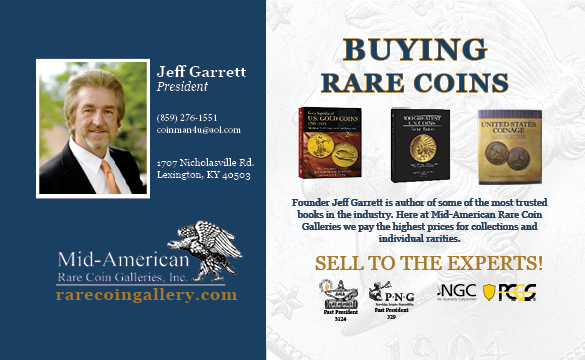
ANA AWARDS HALLENBECK, HUNTOON, AND SAMMUT
Last week we passed along the news that NBS cofounder George Frederick Kolbe won the ANA's Lifetime Achievement Award. Here are other award winners from the ANA's press release. Congratulations! -Editor
The American Numismatic Association (ANA) is honoring several numismatists who not only lead by example, but pave new pathways within the numismatic hobby. Recognized for their dedication, hard work, passion and contributions, these recipients will be acknowledged at the World’s Fair of Money? in Rosemont, Ill., Aug. 13-17.
Those being recognized are:
- Thomas Hallenbeck for the Farran Zerbe Memorial Award for Distinguished Service
- Peter Huntoon for Numismatist of the Year
- Kenny Sammut for the Young Numismatist of the Year
- George Kolbe for the Lifetime Achievement Award
The Farran Zerbe Memorial Award for Distinguished Service is the highest honor conferred by the American Numismatic Association. It is given in recognition of numerous years of outstanding, dedicated service to numismatics. Thomas Hallenbeck is the recipient of this year’s award.
Born in Ft. Wayne in 1961, and having grown up in a numismatic household, Hallenbeck was no stranger to the hobby. "I was introduced to numismatics at birth," said Hallenbeck. His father, Ken, frequently took him and his siblings to local club meetings. In 1983, Ken opened Ken Hallenbeck Coin Gallery, a small storefront near downtown Colorado Springs, and invited his son to join him. Tom accepted the position temporarily, just until a "real job" in banking or finance came along. The rest is history.
Tom has been active in numismatics all his adult life. He was a member of the ANA Board of Governors from 1997 to 2001, elected vice president in 2009-11 and served as president from 2011 to 2013. He has been on the board and was president of the Colorado-Wyoming Numismatic Association. He also was a board member and chairman of the Colorado Professional Numismatists Association.
 Hallenbeck received
the Goodfellow Award for chairing the ANA's 1996 convention in Denver and was named a Numismatic News Ambassador. An ANA Glenn Smedley Memorial
Award (2001) and Medal of Merit (2003) recipient, he also was given an honorary "Doctor of Numismatics" degree at the ANA's 2018 Summer
Seminar.
Hallenbeck received
the Goodfellow Award for chairing the ANA's 1996 convention in Denver and was named a Numismatic News Ambassador. An ANA Glenn Smedley Memorial
Award (2001) and Medal of Merit (2003) recipient, he also was given an honorary "Doctor of Numismatics" degree at the ANA's 2018 Summer
Seminar.
On the Token and Medal Society board from 1998 to 2004, Tom also was vice president of the Colorado Springs Coin Club. In 1970-74 he served as editor of CoinChatter, the publication of the Old Fort Coin Club (Indiana), and he currently sits on the board of the Industry Council for Tangible Assets. In June, Tom completed his 25th consecutive year as a coin-grading instructor at the Summer Seminar.
Hallenbeck and his father hold to the same hobby philosophy and encourage others to collect what they love. They also share the distinction of being the first and, to date, the only father and son to serve as president of the ANA and to receive the Farran Zerbe Memorial Award. Ken had the privilege of installing his son as the 57th president in August 2011.
"My father has had the greatest impact on every aspect of my life," said Hallenbeck, adding, "I learned honesty and persistence from him. His passion for and enjoyment of numismatics, along with his knowledge and integrity, have made my journey in this hobby amazing."
In 2001, Hallenbeck purchased his father's coin shop, changed its name and currently is president. Though the shop is a full-time job, the hobby for Hallenbeck is more than a profession. "Numismatics is all encompassing," he said. "It permeates every aspect of my life."
The Numismatist of the Year, first presented in 1995, was established to recognize individuals within the numismatic community who have demonstrated long-term leadership in the field and to the American Numismatic Association. This year’s recipient is Peter Huntoon.
 A noted author and expert in the field
of National Bank notes, Huntoon has distinguished himself over many decades of service to the ANA and other organizations. Beginning in the late 1990s, Huntoon
and his wife (occasionally assisted by other researchers) sorted and indexed the 52,000 plate proofs of National Bank notes and about 225,000 proofs of other
fiscal paper that had been transferred from the U.S. Bureau of Engraving and Printing to the Smithsonian Institution in the 1970s. This endeavor took well over
a decade, and the couple spent several weeks each year away from home – mostly at their own expense. When that job was complete, they moved on to the National
Archives, where they indexed and created finding aids for 1,200 massive currency and bond ledgers. Their work has been invaluable for scholars. “Numismatic
research and education in the form of writing and teaching have been foundational to my enjoyment of numismatics, and these goals align with those of the ANA,”
says Huntoon.
A noted author and expert in the field
of National Bank notes, Huntoon has distinguished himself over many decades of service to the ANA and other organizations. Beginning in the late 1990s, Huntoon
and his wife (occasionally assisted by other researchers) sorted and indexed the 52,000 plate proofs of National Bank notes and about 225,000 proofs of other
fiscal paper that had been transferred from the U.S. Bureau of Engraving and Printing to the Smithsonian Institution in the 1970s. This endeavor took well over
a decade, and the couple spent several weeks each year away from home – mostly at their own expense. When that job was complete, they moved on to the National
Archives, where they indexed and created finding aids for 1,200 massive currency and bond ledgers. Their work has been invaluable for scholars. “Numismatic
research and education in the form of writing and teaching have been foundational to my enjoyment of numismatics, and these goals align with those of the ANA,”
says Huntoon.
Huntoon has been an instructor at the ANA Summer Seminar since 2002, and in 2004 he coordinated a donation by American Bank Note Company to the ANA’s Edward C. Rochette Money Museum of two complete sets of plate-making artifacts. The ANA is believed to be the only non-governmental museum to hold such materials. Similarly, in 2009 he arranged for the donation of food-coupon proofs, specimens and sheets from the U.S. Department of Agriculture food-stamp program to the ANA.
Huntoon has conducted meticulous research on every aspect of currency production, including the politics, legislation and manufacturing technologies behind it. He has shared his expertise in numismatic periodicals since 1966, and more than 200 of his articles have been published. He has written several books, including Territorials: A Guide to U.S. Territorial National Bank Notes and United States Large Size National Bank Notes. Huntoon is the recipient of many numismatic awards, and is often credited with helping spread the message that a specimen’s history and rarity can make a well-worn note much more valuable than a restored one.
The American Numismatic Association recognizes that the future of the hobby depends on the recruitment and education of young numismatists. The Young Numismatist of the Year award honors young collectors for outstanding contributions to the hobby and industry. Receiving this year’s award is Kenny Sammut.
 Entering his senior year of
high school this fall, the Chadds Ford, Penn., teen is involved in a variety of activities, including playing baseball. But for Sammut, numismatics is front
and center. He was introduced to the hobby in 2007 when his father purchased some Presidential dollars. Since then, his knowledge and involvement in
numismatics have increased and now consume much of his time and energy.
Entering his senior year of
high school this fall, the Chadds Ford, Penn., teen is involved in a variety of activities, including playing baseball. But for Sammut, numismatics is front
and center. He was introduced to the hobby in 2007 when his father purchased some Presidential dollars. Since then, his knowledge and involvement in
numismatics have increased and now consume much of his time and energy.
Sammut’s work ethic and leadership abilities are evident in all areas of his life, but especially in numismatics. His roles have included being the first YN in the Association’s history to be an ANA district representative, as well as serving as a board member for the Wilmington Coin Club in Delaware.
As is so often the case, Sammut’s numismatic trajectory was aided by family, friends and hobby enthusiasts, including many club members and professional numismatists. He relies on his advisors and mentors, some of whom have become his personal heroes.
In addition to participating in traditional hobby activities, Sammut is making the most of social media in his numismatic endeavors. He created and manages a Facebook group, “Coin?Collecting – U.S. and World Coins – Everything Numismatic,” that has more than 2,300 members, and his “Coinswithkenny” account has more than 2,100 followers. “When I first started using social media, mostly adults followed me and were extremely encouraging. Many were happy to see a YN so involved in coin collecting,” he says, adding that “within several months, more and more YNs began to follow me. My audience is now international, and it is great to communicate with collectors around the world.”
After graduation, Sammut hopes to pursue a college degree in international finance and economics, giving him an opportunity to combine his interests in business, global travel and numismatics.
?Sammut received his 2019 ANA Young Numismatist of the Year award at the Association’s Summer Seminar held in Colorado Springs in June.
To read the earlier E-Sylum article, see:
KOLBE WINS ANA LIFETIME ACHIEVEMENT AWARD
(https://www.coinbooks.org/v22/esylum_v22n31a02.html)
ANA AWARDS BEST, DE LEóN TALLAVAS, FITTS
Here's the press release for another batch of awards from the ANA, all well-deserved. Congratulations! -Editor
Chicago World’s Fair of Money®
Numismatics is the study and collection of coins, paper money, tokens and medals, but at the American Numismatic Association (ANA) it is the people who truly define the hobby. Several individuals will be recognized for their service and commitment to numismatics at the upcoming Chicago World’s Fair of Money, August 13-17.
The ANA established the Elvira Clain-Stefanelli Memorial Award for Achievement in Numismatics in 2013 to recognize women who have made notable contributions to the hobby. Named after the former curator of the Smithsonian Institution’s National Numismatic Collection, this honor has been bestowed on many heavy hitters. This year’s deserving recipient, Carrie Best, has been involved in numismatics for more than 40 years.
 Best has been extremely
active in the hobby as a leader, promoter, mentor, dealer and contributor. Specializing in silver art bars and rounds with themes of Christmas, Valentines and
trains, Best deals in U.S. key and semi-key dates and in silver art medals.
Best has been extremely
active in the hobby as a leader, promoter, mentor, dealer and contributor. Specializing in silver art bars and rounds with themes of Christmas, Valentines and
trains, Best deals in U.S. key and semi-key dates and in silver art medals.
A life member and past president (2004-07) of Florida United Numismatists (FUN), Best serves as its treasurer and was co-editor of the organization’s publication FUN Topics for 15 years. She has been Women in Numismatics’ parliamentarian since 2008, and also is secretary/ treasurer of the International Association of Silver Art Collectors and editor of its publication, The Silver Bugle.
Her efforts in promoting numismatics have been recognized by national and state organizations. She received an ANA Presidential Award (1999), as well as a FUN Presidential Award (2011) and its prestigious Award of Merit (2012).
Best has made significant contributions to the hobby, which have had a lasting impact on the numismatic community. The most rewarding part for her has been working behind-the-scenes at coin shows and volunteering with many clubs and organizations. She says, “I am truly honored to have been nominated and selected to receive this award."
Each year, the Association honors an ANA district representative who sets the standard for promoting the hobby and ANA-member clubs throughout the United States. At the World’s Fair of Money, Ricardo de León Tallavas will be presented with the Outstanding District Representative Award for 2019.
 Born in
Monterrey, Mexico, Tallavas developed an interest in coin collecting as a youngster. “It was Father’s Day, and I?was 8 years old when my father talked to me
about the coins he carried in his pocket as a kid,” he recalls.
Born in
Monterrey, Mexico, Tallavas developed an interest in coin collecting as a youngster. “It was Father’s Day, and I?was 8 years old when my father talked to me
about the coins he carried in his pocket as a kid,” he recalls.
Through the years, his passion for the hobby has earned him many accolades. An active member of the Bellaire Coin Club, Greater Houston Coin Club and the United States Mexican Numismatic Association, he still finds time to research and write about Mexican exonumia—his specialty.
Tallavas is a dedicated elementary schoolteacher in the Houston, Texas, area and has incorporated his love of coins into the students’ curriculum. His educational fervor also helps fuel his numismatic enthusiasm, as evidenced by his recurring role as an ANA Summer Seminar instructor. Tallavas is a leading authority on Mexican numismatics, and his classes are well-attended.
Tallavas takes pleasure in sharing his love of collecting on both national and international platforms. Always promoting the hobby, Tallavas oftentimes can be found with a camera around his neck, an infectious smile on his face and a proud glint in his eye as he talks about numismatics.
In an effort to recognize the most important collectors, scholars and hobby professionals of all time, the American Numismatic Association maintains the Numismatic Hall of Fame (HOF) at its headquarters in Colorado Springs, Colorado.
Individuals are recognized annually, with “modern” numismatists inducted in odd years, and “historic” personages in even years. This year, the ANA welcomes to this elite group a notable hobbyist, dealer and scholar—Arthur M. Fitts III.
Born in Framingham, Massachusetts, in 1936, Fitts followed the course set by his paternal grandmother, who bequeathed him an 1881 gold coin. The young collector honed his skills by filling blue Whitman folders with examples of circulating coinage, particularly Buffalo nickels, which he favored.
 Fitts entered
Phillips Exeter Academy in New Hampshire in 1951, followed by four years at Harvard University, where he majored in English history. He went on to become a
master at Fessenden, a private boarding school for boys in Newton, Massachusetts. There he started a coin club and shared his knowledge of numismatics with his
students.
Fitts entered
Phillips Exeter Academy in New Hampshire in 1951, followed by four years at Harvard University, where he majored in English history. He went on to become a
master at Fessenden, a private boarding school for boys in Newton, Massachusetts. There he started a coin club and shared his knowledge of numismatics with his
students.
Fitts joined the ANA in 1955 and today is proud to be life member 951. In 1969 he became a partner in Colony Coin Company in Newtonville and owner in 1978. In 1973 he chaired the ANA’s 82nd Anniversary Convention in Boston. Beginning in January 1974, Fitts served as assistant to ANA Executive Director Edward C. Rochette at the Association’s Colorado Springs headquarters. There he coordinated ANA conventions and was acting curator of the Museum.
A two-term ANA governor (2001-05) and a regular Summer Seminar instructor, Fitts also was a mentor in the ANA Numismatic Diploma Program. He has communicated his enthusiasm for the hobby by delivering more than 25 presentations at ANA conventions across the country, and at least 100 illustrated, educational programs at the local, regional and national level. Over the years, he has contributed scores of feature articles and columns to The Numismatist. With his wife, Prue, also a former member of the ANA Board, Fitts has worked as an ANA national volunteer.
In recognition of his service to the ANA and the hobby, Fitts was presented the ANA’s first Adna G. Wilde Jr. Memorial Award for Excellence (2010). Previously, he was recognized with the Association’s Presidential Award (1994, 1997 and 2009), Medal of Merit (1998), Glenn Smedley Memorial Award (2000), Lifetime Achievement Award (2001) and Exemplary Service Award (2006). In 2012 he and his wife were recognized with the Farran Zerbe Memorial Award for Distinguished Service, the ANA’s highest honor. Arthur Fitts was named a Numismatic Ambassador by Numismatic News in 2001. In 2018 the Fittses established a new annual ANA prize, the Prue and Arthur Fitts Literary Award for Ancient and Medieval Coinage Studies.
COUNTERFEIT COIN MAKERS IN INDIA
The fake coins aren't all coming from China. The Times of India reports on counterfeit coin operations across India. Thanks to the Society of Paper Money Collectors' News & Notes of August 6, 2019 for mentioning the article. -Editor

You know it’s serious when the government sends out a warning. The state archaeology department in Maharashtra has been issuing advisories since March this year, alerting coin collectors and history lovers that several coins of the rare and vintage variety floating around on online portals are counterfeit, urging them to get their coins authenticated by numismatic experts.
Topping the fake list of spurious coins, according to the department, is the Shivrai paisa, a copper coin of low value minted during the Maratha reign that remained in circulation from the 17th till the end of the 19th century, primarily in Bombay Presidency.
The scam was evident when a fresh stash of Shivrai coins were flying off the Internet shelves for anything between Rs 400 and Rs 1000 — one third the existing price — and none of its features matched the original version of the coins minted at Satara between 1664-1819 which lacked sophistication, were octagonal, weighed not more than 9 grams and its letterings worn out with time. Instead its doppelganger flaunted a shiny veneer, a round and uniform shape, weighed heavier, and bore an inscription as clear cut as new.
Several counterfeiters are reported to be active in Gujarat, Bengal, Mumbai and Delhi while Saharanpur in UP and Murshidabad in Bengal are a hub of workshops given their ancestral knowledge of how to carve out a die and strike copper coins from the colonial times. If carbon dating – a method used to determine the age of ancient coins – were applied on these, they’d pass the acid test.
Part of the problem is a lack of formal policing. While the state archaeological departments are involved in security responsibilities of antiquities, it is the Archaeological Survey of India (ASI), whose task is to regulate all archaeological activities in the country. Changes in central rules and insufficient manpower have relegated the task of targeting counterfeits to the background. Coins were recently exempt from the Indian Antiquities Act that obligates objects of stone, miniatures, paintings, bronzes and terracotta of more than 100 years old to be registered with ASI.
“While collectors believe they’ve hit a treasure trove, what they’re taking home are worthless locally made counterfeits,” says Manish Khanna, a 52-year-old coin collector turned anti-counterfeit crusader in Mumbai who has been standing against the wave of fake coins and diligently documenting them.
Khanna a dealer in electrical hardware started an anti-counterfeiting community on Facebook called ‘Vigilante Numismatics’ four years ago after his personal brush with fake coins when he spent Rs 3.5 lakh on what he thought were Mughal coins but turned out to be a sham. His effort to publish diagnostics of forgeries to help coin collectors spot the false ones has over 3200 members today who have helped report at least 25 cases of coin scams in the country. “We keep track of the bestsellers; help analyze an allegedly fake coin. After thorough verification we pin the name and photograph of fraud dealers on the group and also help in lodging FIR if required,” explains Khanna.
A sudden flush of Travancore chakrams was the first counterfeit case the group managed to bust after the market was suddenly flooded with coins in brilliant, shiny condition,” recalls Khanna. “Apart from its look, quality and weight, the supply is a giveaway. Rare coins will change hands, not multiply.” Although this team of vigilantes were able to draw attention to the scam and drive collectors away, “the coins are back in circulation again,” rues Khanna. A quick Internet search reveals Travancore coins on sale for Rs 20,000 and Rs 1 lakh.
There are several instances of such audacious con jobs. In 2015, a Jalpaiguri resident was ready to dish out Rs 13 lakh for a fake “rice puller coin” minted by the East India Company for its seemingly magical properties before the dealer was arrested.
Can anyone tell us the story of the rice puller coin and its supposed magical properties? Internet searches are swamped with fakes and misinformation. Where can a legitimate article/image/lot description be found? -Editor
To read the complete article, see:
Fake or fortune? Technology, e-stores and weak legislation h ..
(https://timesofindia.indiatimes.com/city/kolhapur/fake-or-fortune-technology-e-stores-and-weak-legislation-help-the-counterfeit-coins-industry-mint-money/articleshow/70519038.cms)
To visit the Vigilante Numismatics group on Facebook, see:
https://www.facebook.com/groups/232520953797785/
POLISH 17TH CENTURY SILVER COIN HOARD FOUND
Found via The Explorator newsletter is this article on a 17th century hoard found in a church in Poland. To subscribe to Explorator, send a blank email message to: Explorator-subscribe@yahoogroups.com. See the full article online for more great photos. -Editor
 A treasure trove of 17th century silver coins has been found under the floor of a monastic church.
A treasure trove of 17th century silver coins has been found under the floor of a monastic church.
Archaeologists from the University of Gdansk were working in the presbytery of the 14th century Church of the Saint Andrew the Apostle in the town of Barczewo in Poland’s northern province of Warmia, when they discovered a glazed ceramic mug handle filled with nearly 1,000 coins.
Coins were also scattered around the vessel.
The treasure was hidden underground in the north-western corner of the chancel near what is known as the rainbow arch.
Though covered in dirt and needing a good clean after their 400-year hibernation, the experts from Gdansk said that the coins are relatively well-preserved.
The coins are silver and were struck for the Polish royal crown and bear the image of King Sigismund III Vasa’s long reign (1587-1632).
The find is made up mainly of lower denomination Polish coins, and includes groschens, 1.5 groschens, as well as 3 and 6 groschen coins.
The haul includes many Prussian shillings struck for Prince George Wilhelm Hohenzollern, who was a fief of the Republic of Poland, as well as Lithuanian coins.

To read the complete article, see:
Thousands of 17th century
silver coins found buried in Teutonic Knights’ church
(https://www.thefirstnews.com/article/thousands-of-17th-century-silver-coins-found-buried-in-teutonic-knights-church-7042)

ROYAL MINT REDUCES COIN PRODUCTION
Arthur Shippee and David Pickup passed along BBC News this article on the Royal Mint's non-production of 1p, 2p and £2 coins last year. Thanks. -Editor
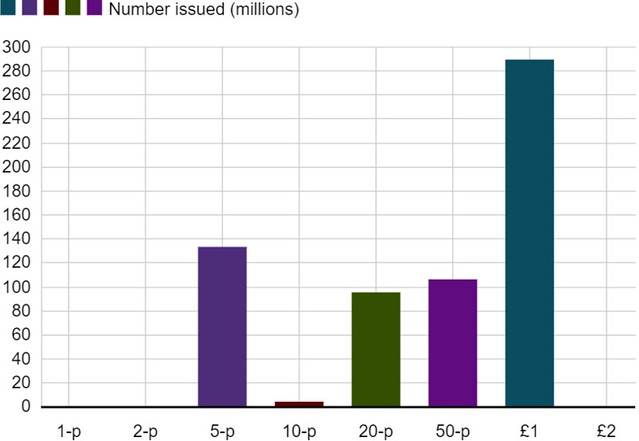
No new 1p and 2p coins were produced by the Royal Mint last year.
It is the first time in decades that it stopped making the coins, as the Treasury said there were already enough in circulation.
There are an estimated 10.5 billion 1p coins and around 6.3 billion 2p coins in use across the UK.
The government said it is not changing the mix of coins and notes, and it is not phasing copper coins out.
The last year that no 1p coins were produced was 1972.
For 2ps, the last year the UK went without new ones was 1984.
In some years there are enough of a certain coin value in circulation so there is no need to produce any more.
The Treasury said no £2 coins were produced either last year, because "there are already enough".
David Pickup adds:
"I think it would be unpopular for the government to announce withdrawing copper coins but perhaps they will disappear gradually."
To read the complete article, see:
Royal Mint: No new 1p coins made for first time in decades (https://www.bbc.com/news/uk-49275300)
Dick Hanscom passed along a Daily Mail article:
Has the penny dropped? MPs warn against scrapping
historic 1p coin 'by stealth' after the Royal Mint produced NONE last year for the first time in nearly FIVE DECADES
(https://www.dailymail.co.uk/news/article-7327347/Royal-Mint-produced-NO-1ps-2ps-year-time-EVER.html)
THE BOWERS COLLECTION OF ENCASED POSTAGE STAMPS
Dave Bowers wrote a blog article about Civil War numismatics and forming his reference collection of U.S. encased postage stamps, which is up for sale at next week's ANA show. -Editor

I have always loved encased postage stamps. When I was a teenager I began to study them, seeking biographies of the various merchants. As time went on I helped form several major collections, including for Jim Ruddy and, in part for John J. Ford, Jr. With Mike Hodder taking the lead, I was co-author of The Standard Catalogue of Encased Postage Stamps published in 1989. My gosh, that was 30 years ago! The book was a best seller and has been out of print for quite a few years. Today on the antiquarian book market, copies sell for more than they did originally! As you read these words I am gathering expanded information for a new book on the subject, perhaps for publication next year. Meanwhile, I have completed the manuscript for a new specialized book to be published by the Token and Medal Society next year: The Story of DRAKE’S PLANTATION BITTERS: A 19th Century Cure-All. I have collected Drake’s items for many years, included bottles, encased postage stamps (here offered), almanacs, and more. I have often thought about doing a book on Dr. J.C. Ayer, but probably will not.
Encased postage stamps are an interesting chapter in the annals of numismatics. In the first decade of the 20th century they were one of the most actively collected series. Far more people collected these than did Morgan silver dollars by mintmarks. In 1901 a typical Drake’s Plantation Bitters stamp cost more than a Mint State 1893-S dollar (today worth several hundred thousand dollars). Such things contribute to the lure and lore of numismatic history.
As to encased postage stamps, these were among several forms of substitute or emergency currency issued during the second year of the Civil War. By late 1861 the outcome of the war was uncertain. Both the Union and the Confederate States of America forces could claim victories. In England, the destination for much of the cotton produced in the South, CSA bonds denominated in British pounds found a ready sale. Citizens became alarmed, and gold coins were hoarded to the extent that by January 1862 they were no longer paid out by banks. Problems continued as the United States Treasury scrambled to raise funds by issuing Legal Tender Notes not redeemable in silver of gold coins. By late spring, all silver coins had disappeared from circulation.
In the second week of July it happened: there were no coins at all in circulation. Even the copper-nickel Flying Eagle and Indian Head cents were gone—into the hands of concerned citizens and speculators. Some hoarders had tens of thousands of them, in one instance causing a floor to buckle from the weight. It was no longer possible to buy a newspaper or a glass of beer, to get a haircut, or pay for a ride on a horse-drawn car.
Rising to the occasion, Congress on July 17 1862, made ordinary postage stamps legal tender! These flimsy, tiny, gummed pieces of paper soon became dirty. They stuck together in hot, humid summer weather, and were a great inconvenience to use as a daily medium of exchange. To make transactions with postage stamps easier, many merchants and others had little envelopes printed with a denomination such as 50 cents lettered on the outside and containing an equivalent face value in loose stamps. Others had tickets and scrip notes printed with the stated value of an envelope’s contents as well as with their business addresses, so once in circulation there was a place to redeem them (for other stamps or paper).
United States Treasurer Francis E. Spinner experimented with the idea of pasting stamps on rectangular cards to create money of recognizable value in more convenient form than loose paper. This led to the creation of Postage Currency, a new class of paper money, printed by contractors in New York City and issued in sheets with perforations that could be torn apart. These were made in denominations of 5¢, 10¢, 25¢, and 50¢ and bore the designs of contemporary stamps printed within a border, and with added inscriptions. The first Postage Currency notes were issued through Army paymasters in August, then to the general public in September. Once quantities reached circulation this eliminated the need for stamps singly or in envelopes.
On August 12, 1862, John Gault, an entrepreneur who had recently moved to New York City from Boston, was awarded a patent for the encased postage stamp (as offered here, and also by Kirkpatrick & Gault). These consisted of a two-part brass frame, the obverse having a pane of clear mica positioned over a postage stamp. The reverse was embossed with an advertising message for different services, products, or other facilities. Denominations included 1, 3, 5, 10, 12, 30, and 90 cents. The lower denominations were the most popular.
These bright little tokens reached circulation soon after the patent date. The New-York Daily Tribune, August 30, 1862, included this under the heading of “City Items”:
“A substitute for coin—A friend has shown us a light circular metallic sheath of white metal, for postage stamps of large and small denominations, the face of the stamp being covered with a transparent sheet of mica. It is slightly smaller in diameter than a quarter of a dollar, and is designed to take the place of small silver coin.
“The metallic back is to be stamped with the advertisement of the houses ordering them. Their price to purchasers is $20 or less a thousand; to the general public, only the value of their face. The idea is not a bad one.”
These encased postage stamps served their purpose well and were common in circulation in the East and Midwest into 1863. In that year cent-size copper (mostly) and brass tokens minted by shops in Cincinnati, New York, Chicago, and elsewhere became dominant. These were of two basic types: (1) Patriotic with a flag, cannons, military leaders, etc., and (2) Store cards issued by over 900 different merchants. Wholesaling at $6 to $7 per thousand tokens, they were inexpensive. In early 1863, when such tokens flooded the country, the issuance of encased postage stamps ended.
Slightly more than 30 merchants and products were advertised on encased postage stamps, with Drake’s Plantation Bitters being one of the largest issuers. Today the lower denominations are often seen and are readily collectible. The higher values are scarce.
When I formed my reference collection, I determined to acquire a “nice” example of the various issuers.. At age 80 I have been deaccessioning favorites such as these, for another generation to enjoy. I hope you as a successful bidder will share my interest.
To read the complete article, see:
Welcome to The Q. David Bowers Reference Collection of
Encased Postage Stamps Featured in Stack’s Bowers Official Auction of the ANA World’s Fair of Money.
(https://www.stacksbowers.com/News/Pages/Blogs.aspx?ArticleID=bowers-encased-stamps-ana-sale)
Here are a few example lot in the sale. Rarely does such a great selection of encased postage come on the market at once. This is a great opportunity for bidders to form or complete their own collections. -Editor
Lot 422 : Ayer's Cathartic Pills. Three Cents


Great silvering. Nice way to start a collection. -Editor
To read the complete lot description, see:
1862
Ayer's Cathartic Pills. Three Cents. HB-5, EP-32, S-3, Reed-AC03SA. Short Arrows.
(https://auctions.stacksbowers.com/lots/view/3-J4CCR/1862-ayers-cathartic-pills-three-cents-hb-5-ep-32-s-3-reed-ac03sa-short-arrows-extremely-fine)
Lot 456: B.F. Miles. One Cent.
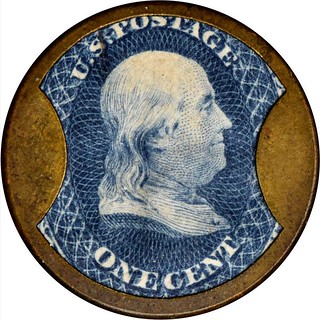

An exceptionally rare piece in exceptional condition. I was never able to add one of these to my EPS collection. -Editor
To read the complete lot description, see:
1862 B.F. Miles. One Cent.
HB-182, EP-22, S-134, Reed-MI01.
(https://auctions.stacksbowers.com/lots/view/3-J4BUC/1862-bf-miles-one-cent-hb-182-ep-22-s-134-reed-mi01-about-uncirculated)
Lot 466: White the Hatter. One Cent.
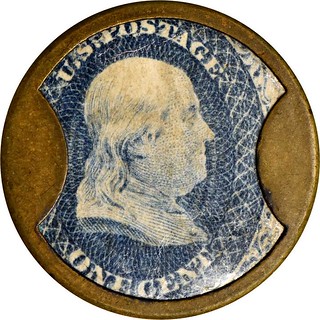

Another merchant I was unable to obtain. I toyed with buying one from Steve Tannenbaum at about $2,000, but got cold feet. -Editor
To read the complete lot description, see:
1862 White the Hatter.
One Cent. HB-234, EP-30, S-178, Reed-WH01.
(https://auctions.stacksbowers.com/lots/view/3-J4CS3/1862-white-the-hatter-one-cent-hb-234-ep-30-s-178-reed-wh01-extremely-fine)
STEPPING THE MAST WITH PENGUINS
"Stepping the Mast" is an ancient shipbuilding tradition wherein a coin or coins are added for good luck. This article describes how a penguin coin was used in the construction of a polar expedition cruise ship. -Editor
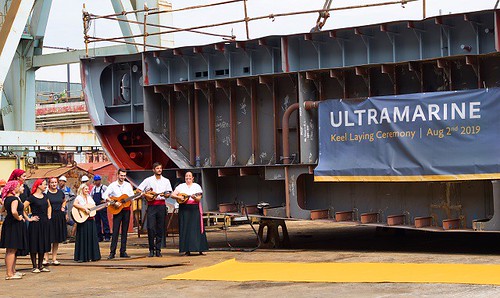
Quark Expeditions held the keel-laying ceremony for its new expedition cruise ship Ultramarine on August 2 at Brodosplit in Croatia.
The keel-laying event, which also marks formal recognition of the 128-meter, 199-passenger vessel, included a Croatian folk music performance, as well as the centuries-old coin ceremony, in which a specially chosen coin is welded into the ship’s hull to ensure good fortune during the build and subsequent voyages.
 “The coin we chose is a beautiful
silver coin featuring two Emperor penguins,” says Malcolm Ellis, Senior VP Operations at Quark Expeditions. “We chose this coin because it perfectly embodies
Quark’s mission: to push the boundaries of polar exploration. In our three decades of operation, Quark Expeditions has accomplished a long list of polar
firsts, including being the first to take guests to Snow Hill Island to engage with Emperor penguins in their natural habitat. Ultramarine’s mix of
design ingenuity and technological innovation will allow us to continue adding to that list of firsts by taking guests further into the polar regions than ever
before.”
“The coin we chose is a beautiful
silver coin featuring two Emperor penguins,” says Malcolm Ellis, Senior VP Operations at Quark Expeditions. “We chose this coin because it perfectly embodies
Quark’s mission: to push the boundaries of polar exploration. In our three decades of operation, Quark Expeditions has accomplished a long list of polar
firsts, including being the first to take guests to Snow Hill Island to engage with Emperor penguins in their natural habitat. Ultramarine’s mix of
design ingenuity and technological innovation will allow us to continue adding to that list of firsts by taking guests further into the polar regions than ever
before.”
Ultramarine is purpose-built for polar sailing. The vessel's off-ship adventure options will include activities such as flight-seeing, heli-hiking and heli-skiing. She will have two twin-engine helicopters and two helidecks.
So... can anyone tell us more about the coin? Where/when was it made? -Editor
To read the complete article, see:
Quark Expeditions Holds Keel-Laying Ceremony
for Ultramarine (https://www.maritime-executive.com/article/quark-expeditions-holds-keel-laying-ceremony-for-ultramarine)
MEXICO MINT GOLD COIN ROBBERY
Arthur Shippee was among the first to send in an article on the Mexico Mint robbery this week. Thanks also to Pablo Hoffman, Len Augsburger and others for passing articles along. -Editor
 Armed
robbers have stolen more than $2m worth of gold coins from a vault that had been left open at a mint in Mexico City.
Armed
robbers have stolen more than $2m worth of gold coins from a vault that had been left open at a mint in Mexico City.
The daylight robbery was the latest high-profile crime to hit the capital city amid record levels of lawlessness across the country.
Two people, one wielding a firearm, broke into the government coin manufacturer on Tuesday, throwing a security guard to the ground and taking his gun, police said.
One of the robbers then went to the vault, which was open, and filled a backpack with 1,567 gold coins, police said.
The coins, known as “centenarios”, have a face value of 50 pesos, but trade for 31,500 pesos ($1,610) apiece, according to Mexican bank Banorte. That makes the total value of the haul at least $2.5 million.
The coin was first minted in 1921 to commemorate the 100th anniversary of Mexico’s independence from Spain, according to the central bank. Production was suspended in 1931, but the coin was re-minted beginning in 1943 due to demand for gold coins.
To read the complete article, see:
Thieves strike gold after
taking $2.5m in coins from open vault at Mexican mint
(https://www.theguardian.com/world/2019/aug/07/thieves-strike-gold-after-taking-25m-in-coins-from-open-vault-at-mexican-mint)
For other articles on the topic, see:
Mexico robbery: Armed gang seizes gold coins from mint
(https://www.bbc.com/news/world-latin-america-49259673)
Robbers steal $2.5 million in coins from Mexico's mint in daylight
heist (https://www.cnn.com/2019/08/07/americas/mexico-city-heist-scli-intl/index.html)
Gunmen steal $2.5M in gold coins from open vault at Mexican mint HQ
(https://www.foxnews.com/world/gunmen-mexico-mint-gold-coins-millions)
Pablo adds:
"For Spanish-speakers, here is the news item from El Comercio, a major Mexico city newspaper."
To read the complete article, see:
Robo
multimillonario en la Casa de Moneda de México | VIDEO
(https://elcomercio.pe/mundo/mexico/mexico-robo-multimillonario-casa-moneda-ciudad-oro-2-millones-dolares-cdmx-video-youtube-noticia-nndc-662547)
The first report I saw on the robbers was Saturday morning in The Daily Mail. The article includes security camera footage of the event. -Editor
 Mexican authorities have identified
three of the four thieves that into walked into the federal mint's headquarters and stole $2.5 million of gold coins from a vault Tuesday morning.
Mexican authorities have identified
three of the four thieves that into walked into the federal mint's headquarters and stole $2.5 million of gold coins from a vault Tuesday morning.
The Mexico City Attorney General's office said police investigators were able to recognize two cousins, Edgar Tenorio and Pablo Tenorio, after interviewing Edgar's father, who was able to positively identify them on surveillance camera images.
Edgar's father told authorities that he had not seen his son since early Tuesday when he left the family home and said he had 'important business to take care off.'
A third suspect was identified as Yahel López. Investigators said a fourth suspect is the girlfriend of one of the three men.
Authorities said the suspects are aged between 25 to 30.
The mint's CCTV cameras showed the moment López walks into the wide-open vault and placed a suitcase on the floor that Edgar was seen entering with.
To read the complete article, see:
Two of the four robbers
who stole $2.5 million from a mint in Mexico City are identified as COUSINS - and one is the neighbor of a security guard at the building
(https://www.dailymail.co.uk/news/article-7342357/Two-four-robbers-stole-2-5-million-mint-Mexico-City-identified-COUSINS.html)
LIFE AND DEATH OF THE BIN LADEN
Pablo Hoffman forwarded this Slate article about "A different kind of paper money collector." -Editor

Earlier this year, the European Central Bank stopped all production of the 500 euro note. The action came after years of concern from academics, multinational police agencies, and EU finance ministers: The 500 euro, they alleged, had grown far too popular in the funding and facilitation of drug trafficking, human smuggling, and terrorism. Because of its illicit reputation—and because “many know what it looks like” but “few have ever seen one”—the European media ominously dubbed the note “the Bin Laden.”
The article's subtitle is, "The short-lived 500 euro bill became the currency of choice for international criminals. But eliminating it may not solve the problem." It's an interesting article, with interviews with former money launderers.
"According to his brother, Roberto, Colombian drug kingpin Pablo Escobar’s operation would lose up to 10 percent of its cash proceeds—a couple of billion a year—in part because rats would eat it in storage." See the full article online. -Editor
To read the complete article, see:
The Life and Death of the Bin Laden
(https://slate.com/news-and-politics/2019/08/euros-500-bin-ladens.html)
TOM BADLEY'S PORTFOLIO OF MONEY
Here are some examples of banknote designer Tom Badley's work that caught my eye. As noted earlier, this was found via the Society of Paper Money Collectors' News & Notes August 6, 2019. -Editor
The Brixton Pound
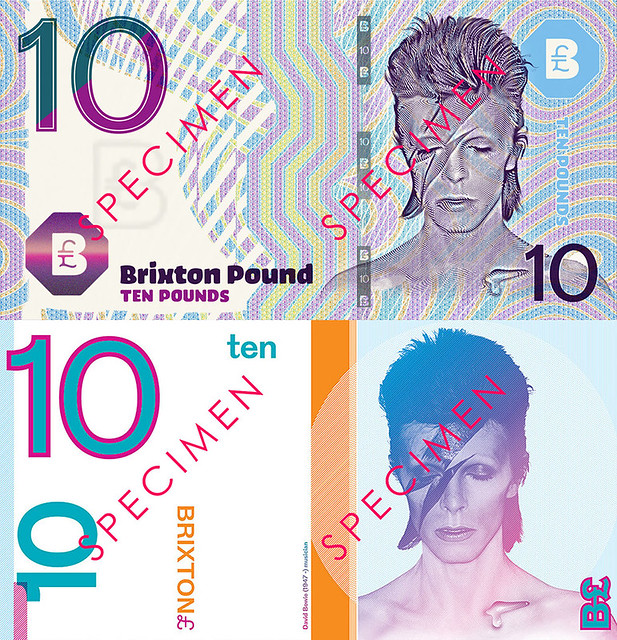
I ‘upgraded’ the original design of the UK’s best known alternative local currencies, the Brixton Pound. This design experiment came from talking to the designers of the Brixton Pound, who did everything they could to purposely reject the appearance of money, as an artistic and somewhat political statement – by rejecting the aesthetics of banknotes, the designers aimed to capture a spirit of revolution and ‘people power’. Thus, the Brixton Pound’s punk design is made of the bare minimum: numbers, portrait, text, and little else.
The aesthetics of banknotes have a vital function: they protect a currency from counterfeiting. None of the design features of a banknote are trivial, nor are they pompously decorative. The complexity of banknote design and hi-spec print processes allow the public to easily tell the difference between real and fake.
My ‘upgrade’ of the Brixton Pound features 3 colour intaglio, 4 colour rainbow offset, OVMI, security strip, microlettering, watermark, and continuous design.
An Alternative Sovereign UK Currency
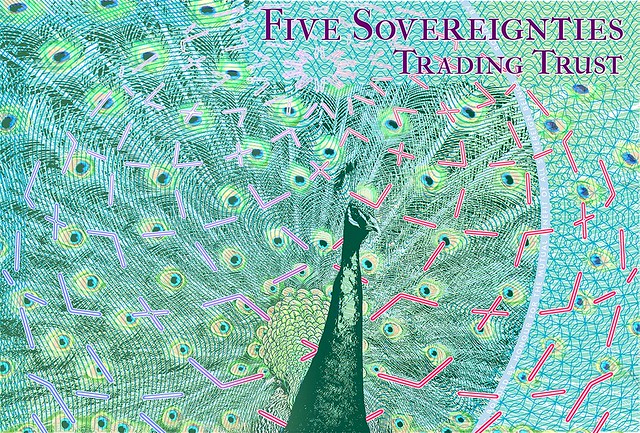
The notes have a similar composition to the current Bank of England notes. The 3 notes are themed around different geometries: 5 – the Fibonacci sequence, 10 – fractal geometry, 20 – the hexagon.
The Trump Note
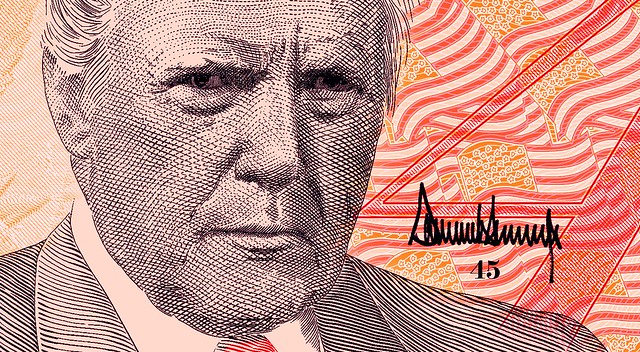
A rough sketch of a forthcoming banknote design, featuring President Donald Trump has been released and circulated on social media. The note is scheduled for release in July, and pays homage to the President’s first 4 years in office.
The ‘Trump note’ will feature a hand-engraved portrait of the 45th President of the United States.
Edward Snowden Note
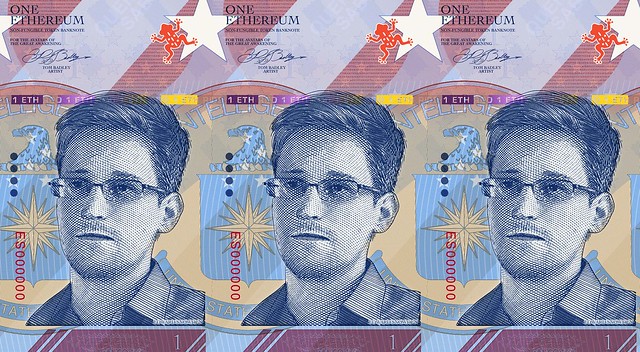
The Deplorables is a series of designs that honor popular figures who advocate principles of privacy, transparency, and truth – in particular, those associated with the revelation of secrets. The notes are denominated in the popular cryptocurrency Ethereum and have been specially produced as NFTs – Non-Fungible Tokens – digital assets on the blockchain with a prescribed scarcity. A physical version of these series is planned, while the NFT artwork is available on the Blockchain Art Exchange, in a limited edition of 20.
The next design in the Deplorables series, featuring Edward Snowden, available exclusively on the Blockchain Art Exchange.
For more information, see:
PROJECTS A Portfolio Of Money (https://www.bitcoin-banknote.com/#port)

